Nokia Solutions and Networks T6EK1 1X-EVDO SC480 BTS Microcell Base Station Transmtr User Manual print instructions
Nokia Solutions and Networks 1X-EVDO SC480 BTS Microcell Base Station Transmtr print instructions
Contents
- 1. User Manual Part 1 of 4
- 2. User Manual 2 of 4
- 3. User Manual 3 of 4
- 4. User Manual 4 of 4
User Manual 4 of 4
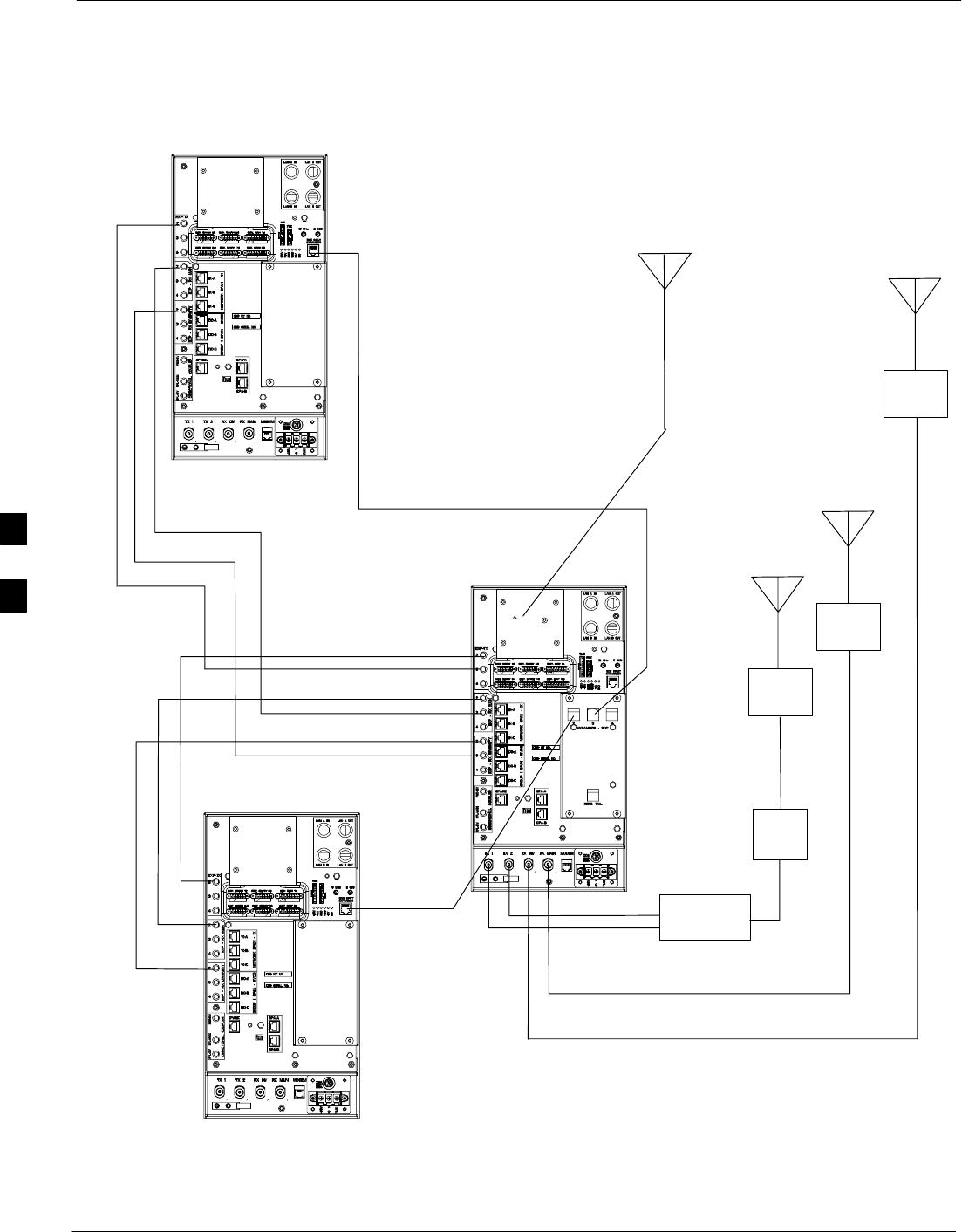
Compact BTS Expansion Configuration (Indoor) – continued
E-18 1X SC480 BTS Hardware Installation, Optimization/ATP, and FRU Jun 2004
DRAFT
Figure E-8: Two Expansion BTSes Cabling Diagram
EXPANSION 2
EXPANSION 1
STARTER
LOCAL GPS
Power and Ground not shown
Ensure that the expansion
BTSes have the expansion
cMPC cards installed.
COMBINER
TX 1
RX MAIN
RX DIV
TX 2
DC
LA
LA
LA
E
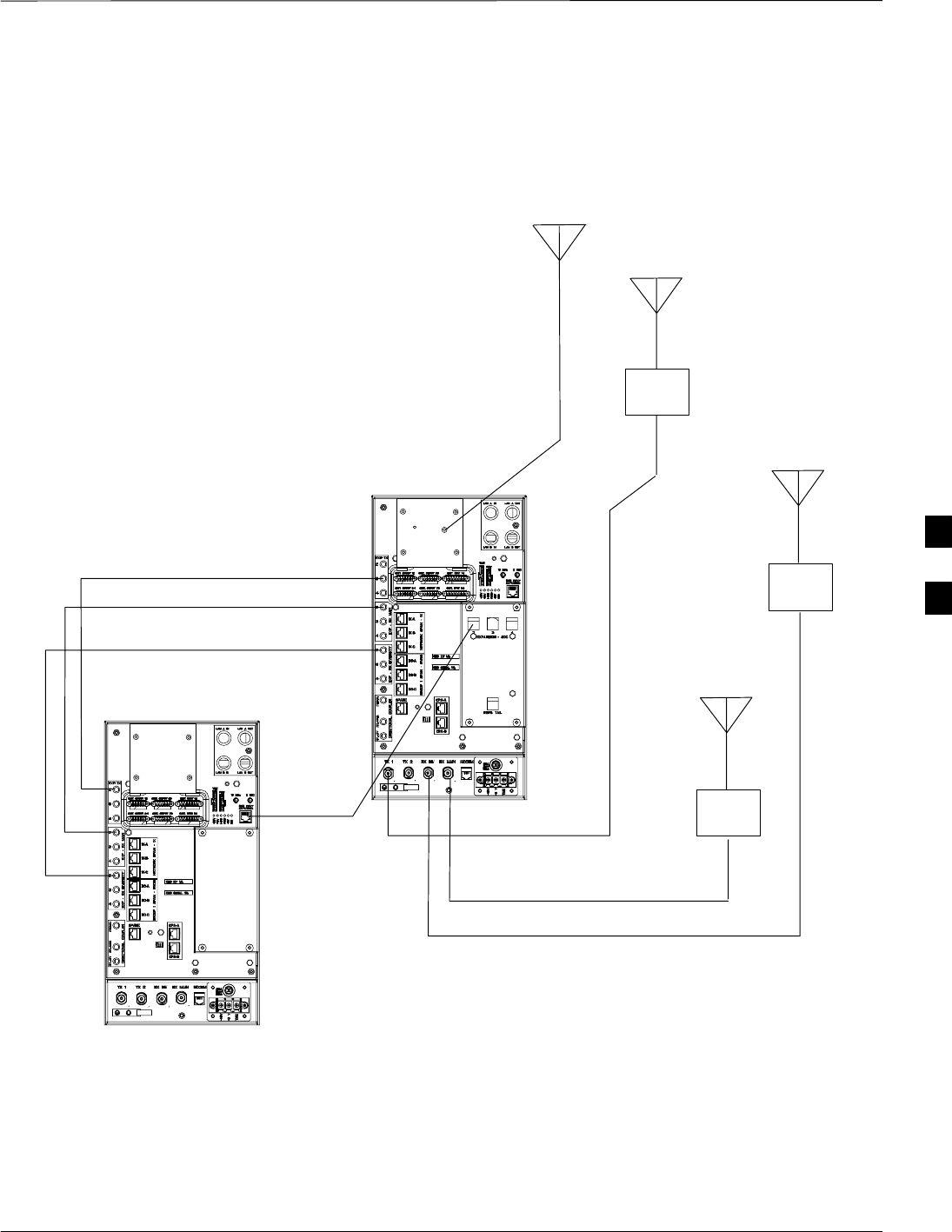
Compact BTS Expansion Configuration (Indoor) – continued
Jun 2004 1X SC480 BTS Hardware Installation, Optimization/ATP, and FRU E-19
DRAFT
EXPANSION 1
STARTER
LOCAL GPS
Figure E-9: One Expansion BTS Cabling Diagram
Power and Ground not shown
Ensure that the expansion
BTS has an expansion cMPC
card installed.
TX 1
RX MAIN
RX DIV
LA
LA
LA
E

Compact BTS Expansion Configuration (Indoor) – continued
E-20 1X SC480 BTS Hardware Installation, Optimization/ATP, and FRU Jun 2004
DRAFT
Table E-11: BBX (Carrier) to cCLPA Via RS485
BTS cCLPA
Starter – BBX1 cCLPA–1
Starter – BBX4 cCLPA–1
Expansion 1 – BBX1 cCLPA–2
Expansion 1 – BBX4 cCLPA–2
Expansion 2 – BBX1 cCLPA–1
Expansion 2 – BBX4 cCLPA–1
Expansion 3 – BBX1 cCLPA–2
Expansion 3 – BBX4 cCLPA–2
Table E-12 shows in tabular format the BTS–to–cCLPA cabling of
Figure E-1.
Table E-12: Starter and Three Expansion BTS Cabling for
Circuit or Packet to Dual cCLPAs
BTS cCLPA
Starter – BBX1 CPA–A (CPA–1)
Starter – BBX4 CPA–A (CPA–1)
Expansion 1 – BBX1 CPA–B (CPB–2)
Expansion 1 – BBX4 CPA–B (CPB–2)
Expansion 2 – BBX1 CPA–A (CPA–1)
Expansion 2 – BBX4 CPA–A (CPA–1)
Expansion 3 – BBX1 CPA–B (CPA–2)
Expansion 3 – BBX4 CPA–B (CPA–2)
Starter and Two Expansion
BTSes to cCLPA Cabling
Table E-13 shows in tabular format the BTS–to–cCLPA cabling of
Figure E-2.
E
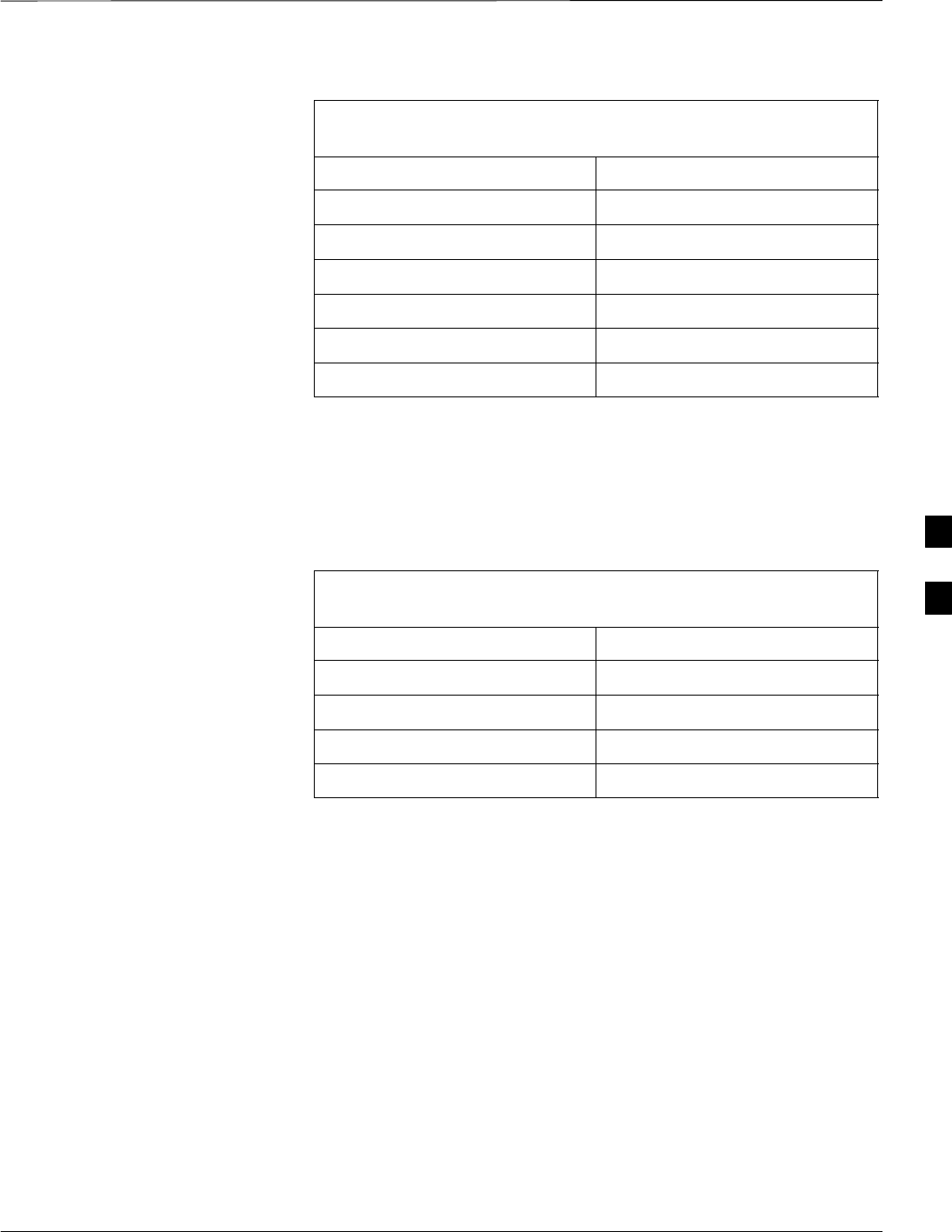
Compact BTS Expansion Configuration (Indoor) – continued
Jun 2004 1X SC480 BTS Hardware Installation, Optimization/ATP, and FRU E-21
DRAFT
Table E-13: Starter and Two Expansion BTS Cabling for
Circuit or Packet to Dual cCLPAs
BTS cCLPA
Starter – BBX1 CPA–A (CPA–1)
Starter – BBX4 CPA–A (CPA–1)
Expansion 1 – BBX1 CPA–B (CPB–2)
Expansion 1 – BBX4 CPA–B (CPB–2)
Expansion 2 – BBX1 CPA–A (CPA–1)
Expansion 2 – BBX4 CPA–A (CPA–1)
Starter and One Expansion
BTS to cCLPA Cabling
Table E-14 shows in tabular format the BTS–to–cCLPA cabling of
Figure E-3.
Table E-14: Starter and One Expansion BTS Cabling for
Circuit or Packet to Dual cCLPAs
BTS cCLPA
Starter – BBX1 CPA–A (CPA–1)
Starter – BBX4 CPA–A (CPA–1)
Expansion 1 – BBX1 CPA–B (CPB–2)
Expansion 1 – BBX4 CPA–B (CPB–2)
E

Multiple Compact BTS Configuration (Outdoor)
E-22 1X SC480 BTS Hardware Installation, Optimization/ATP, and FRU Jun 2004
DRAFT
Introduction
This section covers only the outdoor version of the multiple Compact
BTS configuration.
Materials Needed
The following materials are required to configure expansion BTSes.
SVaried length cables with RJ45 connectors
SVaried length cables with RF connectors
SConduit (customer supplied)
SDC Power source (custoemr supplied)
SBattery Backup (customer supplied)
External Combiner and
Directional Coupler
A combiner and directional coupler are required for some of the
configurations. The following are the recommended specifications for
the combiner and directional coupler.
Table E-15: Combiner and Directional Coupler Specifications
Item Specifications
Combiner
Connector: N–Type
Frequency Range: Up to 2 GHz
Insertion Loss: 3.5 dB maximum
Return Loss: 16 dB minimum
Average Input Power: 60 Watts minimum
Directional Coupler
Connector: N–Type
Frequency Range: 810 to 950 MHz
Coupling: 30 +/–1 dB
Directivity: 28 dB minimum
Return Loss: 18 dB minimum
Average Input Power: 10 Watts minimum
SMotorola recommended directional coupler is P/N 809643T03
SRecommended cable with combiner is Andrew LDF4–50 or
equivalent
E
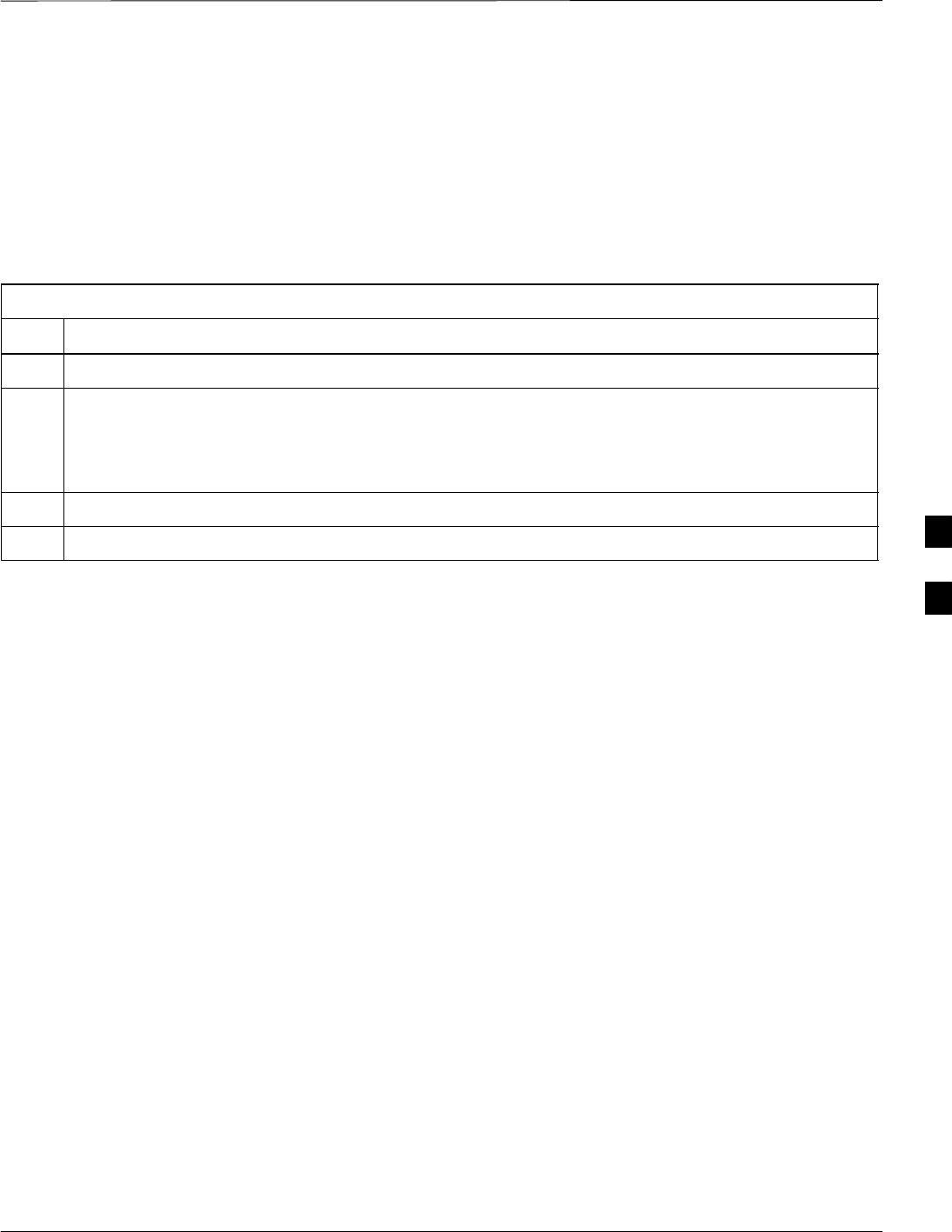
Multiple Compact BTS Configuration (Outdoor) – continued
Jun 2004 1X SC480 BTS Hardware Installation, Optimization/ATP, and FRU E-23
DRAFT
SDirectional coupler and combiner are not environmentally protected ,
and so must be placed within the TME.
ExpansionCompact BTS
Installation Procedure
Follow the procedure in Table E-16for installation of multiple Compact
BTSes.
Table E-16: Procedure for Installing Expansion Compact BTSes
Step Action
1Follow the procedure in Chapter 4 for installing a Compact BTS in a rack.
2For a 3 BTS expansion configuration, follow Figure E-1. Proceed to step 3.
2a For a 2 BTS expansion configuration, follow Figure E-2. Proceed to step 3.
2b For a 1 BTS expansion configuration, follow Figure E-3. Proceed to step 3.
3If conduit is not used, dress cables as necessary.
4Perform Optimization and ATP as described in Chapter 6. LMF Help provides further information.
Frame ID Switch Settings
Refer to Chapter 5, Figure 5-1 or Figure 5-2 or Table 5-1 through
Table 5-4 for the Frame DIP Switch settings.
E
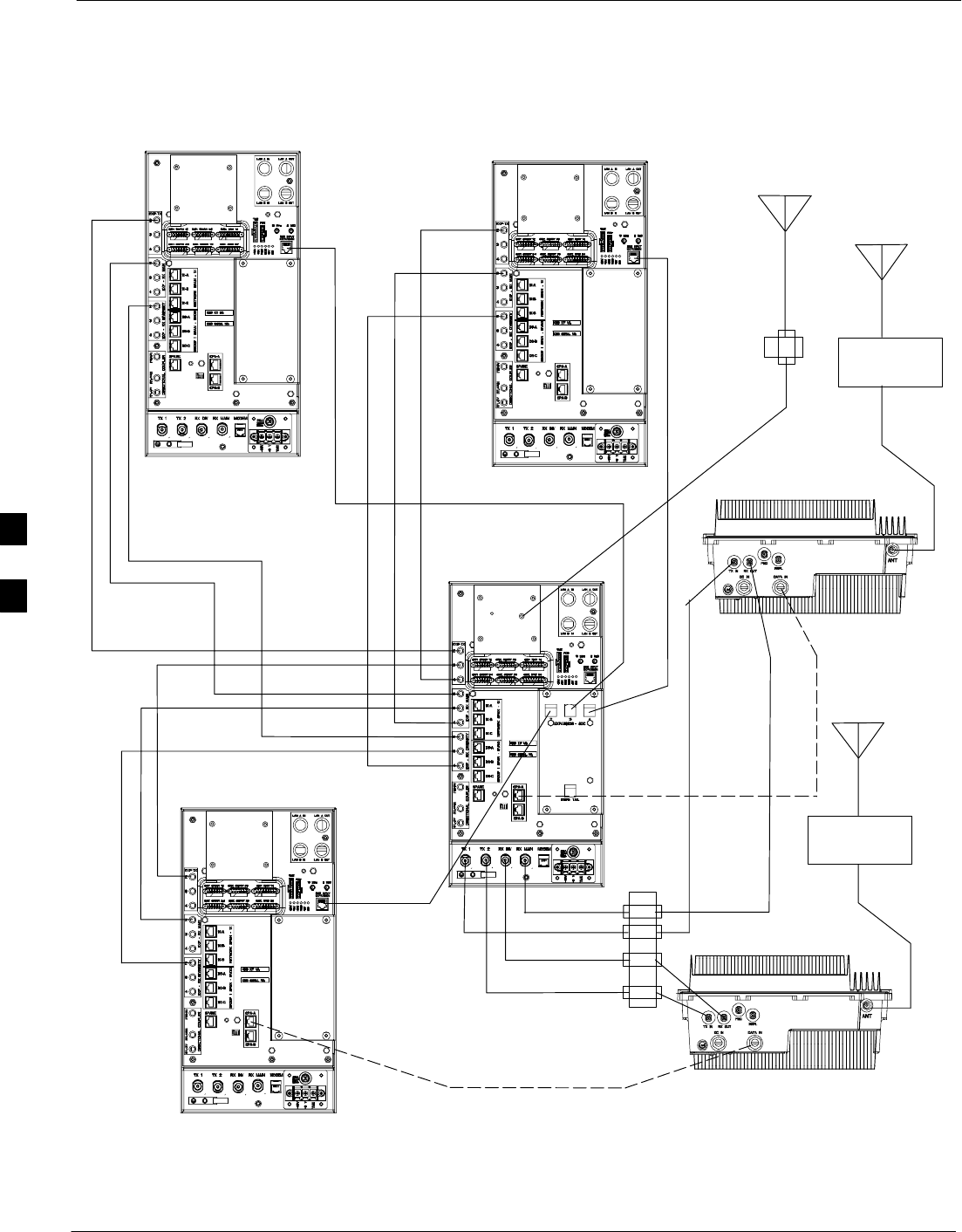
Multiple Compact BTS Configuration (Outdoor) – continued
E-24 1X SC480 BTS Hardware Installation, Optimization/ATP, and FRU Jun 2004
DRAFT
Figure E-10: Three Expansion BTSes Cabling Diagram
LIGHTNING
ARRESTOR
LIGHTNING
ARRESTOR
EXPANSION 3
EXPANSION 2
EXPANSION 1
STARTER
cCLPA 1
cCLPA 2
LOCAL GPS
TX1
TX2
RX DIV
RX MAIN
TME ANTENNA
CONNECTORS
TME
RF–GPS
CONNECTOR
Power and Ground not shown
E
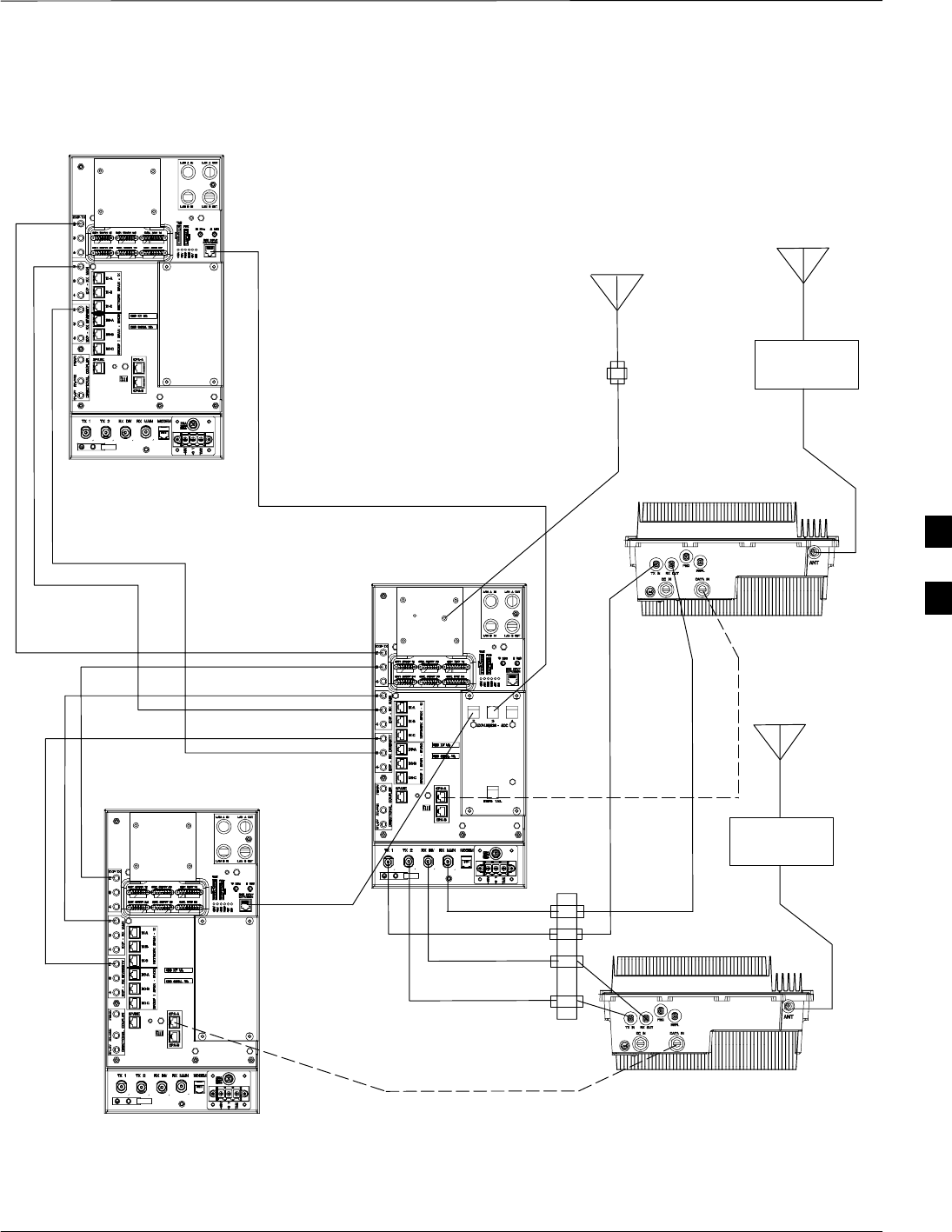
Multiple Compact BTS Configuration (Outdoor) – continued
Jun 2004 1X SC480 BTS Hardware Installation, Optimization/ATP, and FRU E-25
DRAFT
Figure E-11: Outdoor Two Expansion BTSes Cabling Diagram
LIGHTNING
ARRESTOR
LIGHTNING
ARRESTOR
EXPANSION 2
EXPANSION 1
STARTER
cCLPA 1
cCLPA 2
LOCAL GPS
TME
RF–GPS
CONNECTOR
TX2
TX1
RX MAIN
RX DIV
TME ANTENNA
CONNECTORS
Power and Ground not shown
E
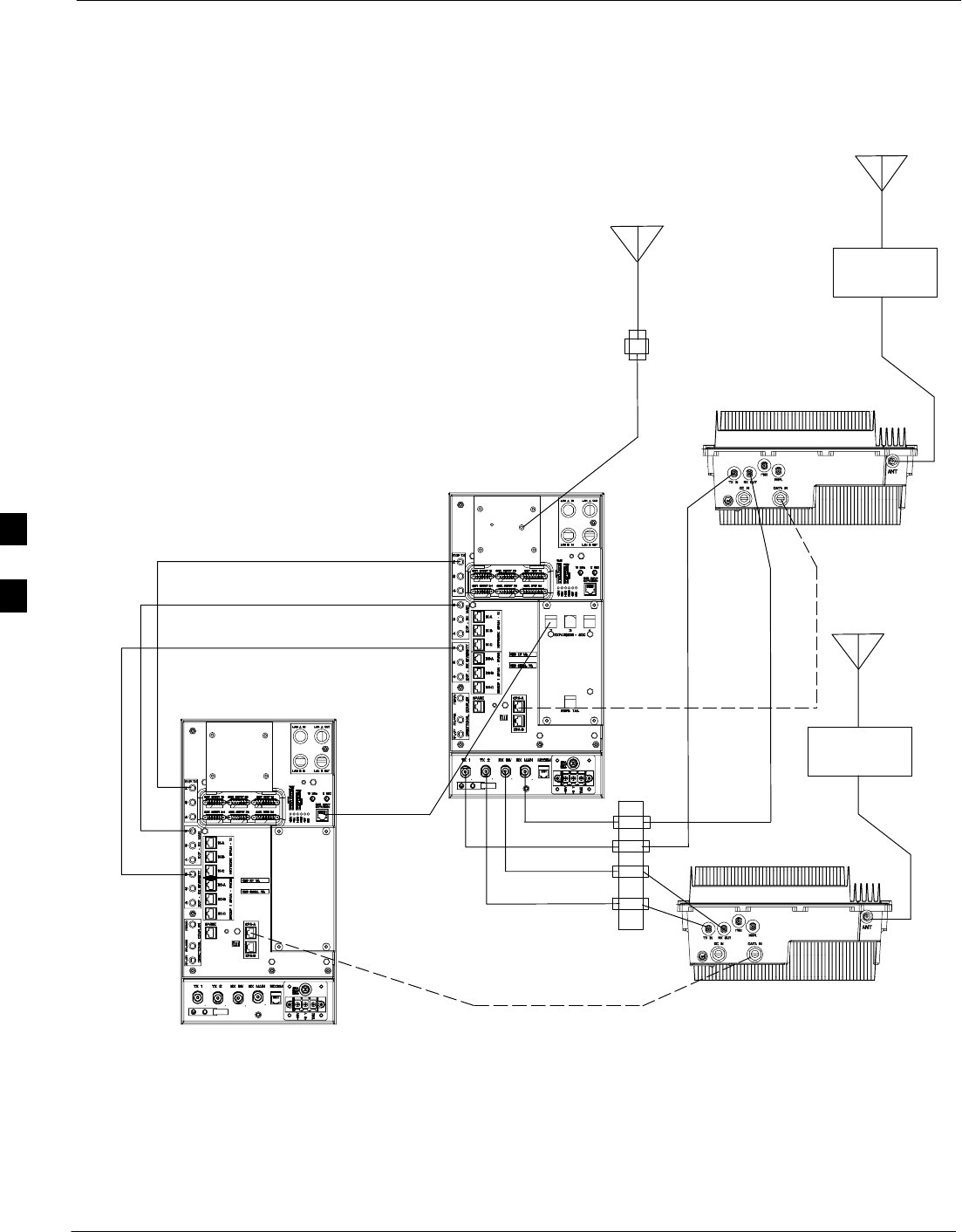
Multiple Compact BTS Configuration (Outdoor) – continued
E-26 1X SC480 BTS Hardware Installation, Optimization/ATP, and FRU Jun 2004
DRAFT
LIGHTNING
ARRESTOR
LIGHTNING
ARRESTOR
EXPANSION 1
STARTER
cCLPA 1
cCLPA 2
LOCAL GPS
Figure E-12: Outdoor One Expansion BTS Cabling Diagram
TME
RF–GPS
CONNECTOR
TX1
RX MAIN
RX DIV
TX2
TME ANTENNA
CONNECTORS
Power and Ground not shown
Other Diagrams
For single cCLPA and no cCLPA, refer to the diagrams for indoor and
allow for the TME connectors as shown in the diagrams presented in this
appendix.
E

Jun 2004 1X SC480 BTS Hardware Installation, Optimization/ATP, and FRU
DRAFT
Appendix F: Logical BTS Configuration
Appendix Content
Logical BTS LAN Configuration for Compact BTS (Indoor) F-1 . . . . . . . . . . . . . .
Introduction F-1 . . . . . . . . . . . . . . . . . . . . . . . . . . . . . . . . . . . . . . . . . . . . . .
Materials Needed F-1 . . . . . . . . . . . . . . . . . . . . . . . . . . . . . . . . . . . . . . . . . .
BTS ID Switch Settings F-1 . . . . . . . . . . . . . . . . . . . . . . . . . . . . . . . . . . . . .
Logical BTS LAN Cabling Installation Procedure F-3 . . . . . . . . . . . . . . . .
F

Table of Contents – continued
1X SC480 BTS Hardware Installation, Optimization/ATP, and FRU Jun 2004
DRAFT
Notes
F
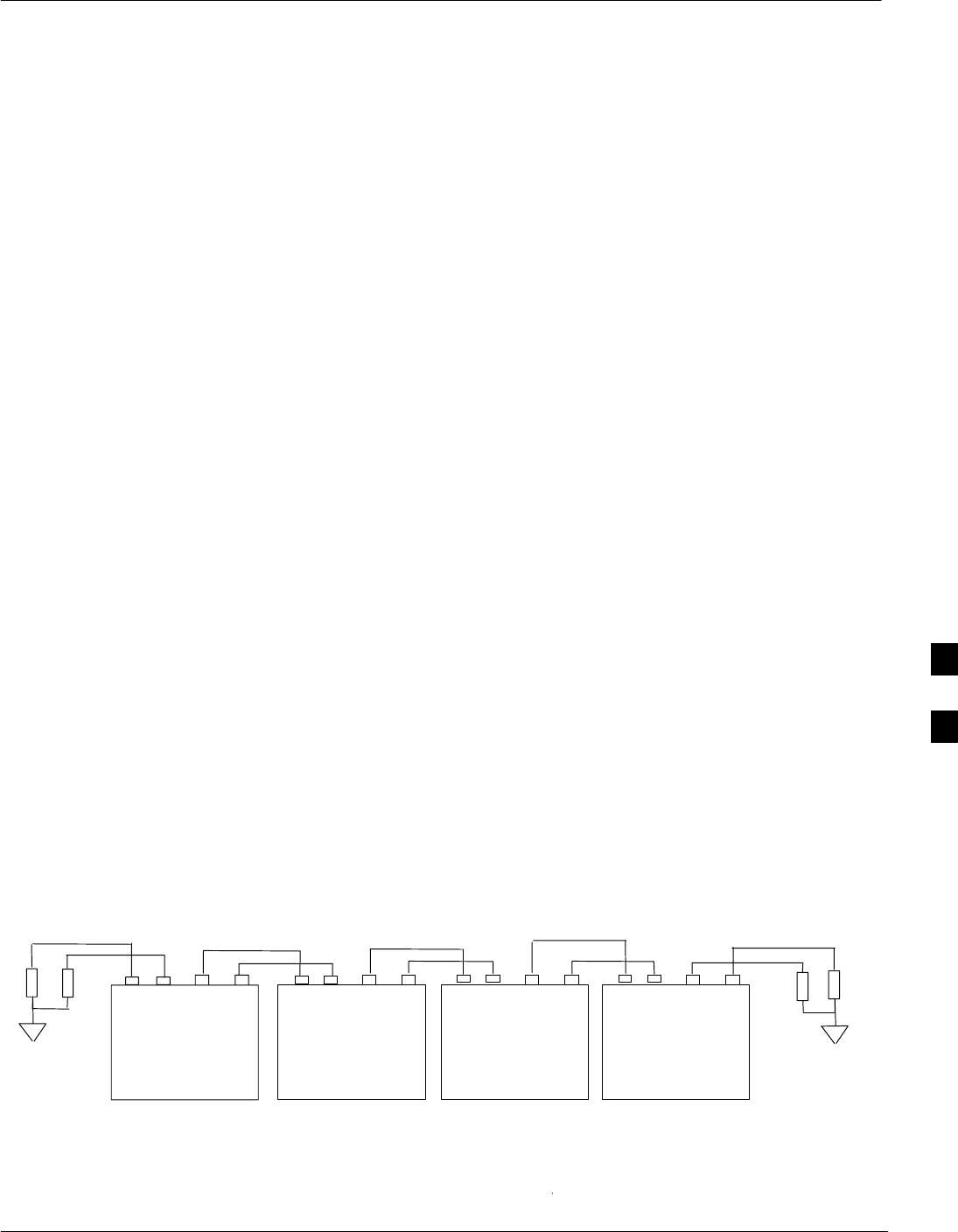
Logical BTS LAN Configuration for Compact BTS (Indoor)
Jun 2004 1X SC480 BTS Hardware Installation, Optimization/ATP, and FRU F-1
DRAFT
Introduction
This appendix covers only the Logical BTS configuration for cicruit
Compact BTS. The diagrams cover only the LAN connections. This
configuration is set up to be used only with other Compact BTSes.
Power and ground cabling are not shown.
The LAN operates at 10Mbps which is an ethernet standard. It provides
an interface for each GLI in the confiiguration.
Refer to Figure 6-1 for location of the LAN connectors. In circuit mode,
the LAN connections are used by the LMF to download data, and for use
in calibration, acceptance testing, and optimization.
Use these diagrams in conjunction with the diagrams for expansion
BTSes in Appendix E.
Logical BTS for 1.9 GHz, +27V A or B band circuit configurations is
not supported.
Materials Needed
The following materials are required to configure LAN connections
BTSes.
S7 – RG–58 U cables (Length depends on spacing)
S14 – BNC, Terminaton Resistor Plugs (IEC 169–8 spec)
S2 – BNC, 50 Ohm terminations
BTS ID Switch Settings
Refer to Chapter 5, Figure 5-1 or Figure 5-2 or Table 5-1 through
Table 5-4 for the BTS DIP Switch settings.
EXPANSION 3
EXPANSION 2
EXPANSION 1
STARTER
Figure F-1: Three Expansion BTSes LAN Cabling Diagram
Aout Bout
Ain Bin Aout Bout
Ain Bin Aout Bout
Ain Bin Aout Bout
Ain Bin
50–ohm
Loads
50–ohm
Loads
F
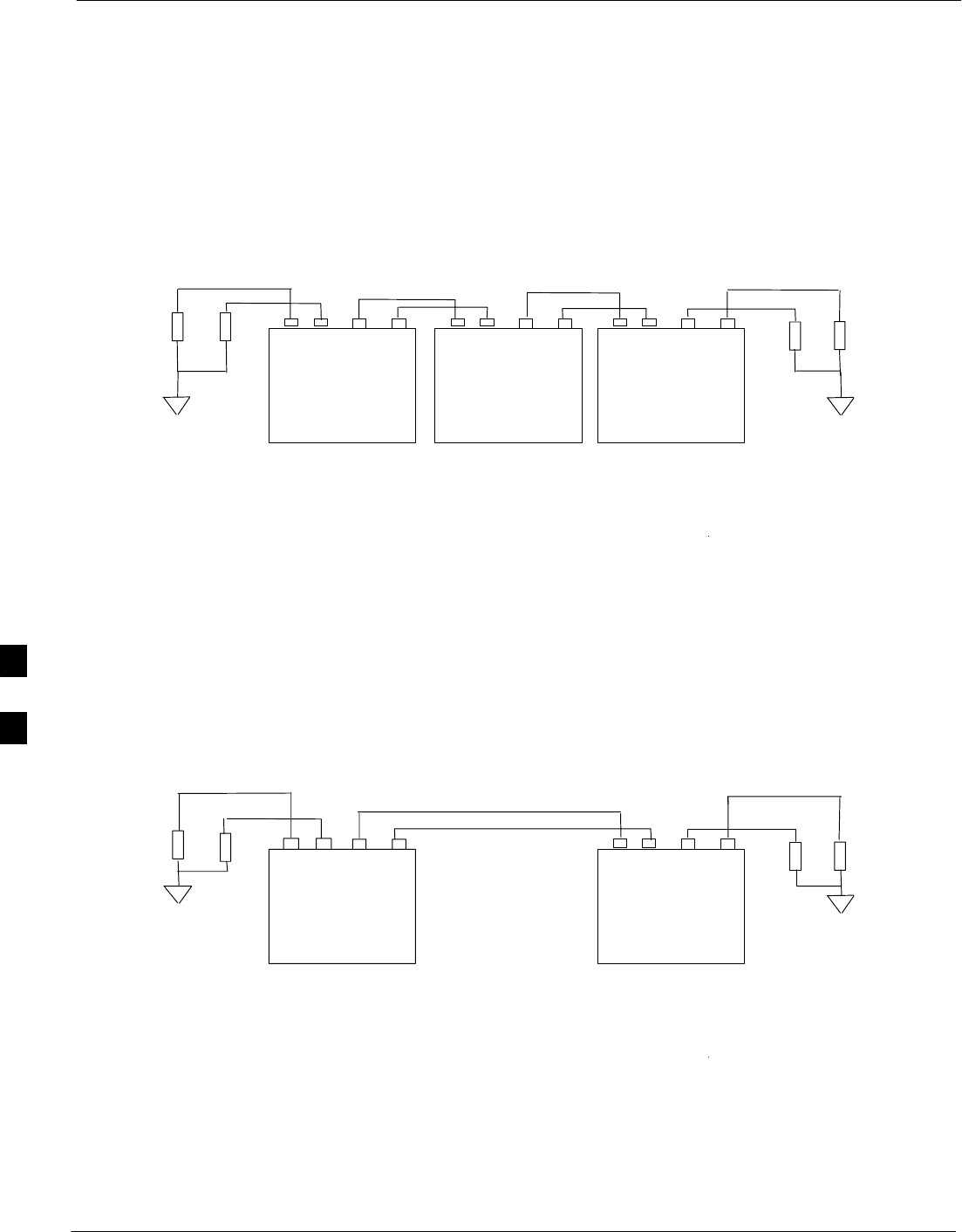
Logical BTS LAN Configuration for Compact BTS (Indoor) – continued
F-2 1X SC480 BTS Hardware Installation, Optimization/ATP, and FRU Jun 2004
DRAFT
EXPANSION 2
EXPANSION 1
STARTER
Figure F-2: Two Expansion BTSes LAN Cabling Diagram
Aout Bout
Ain Bin Aout Bout
Ain Bin Aout Bout
Ain Bin
50–ohm
Loads
50–ohm
Loads
EXPANSION 1
STARTER
Figure F-3: One Expansion BTS LAN Cabling Diagram
Aout Bout
Ain Bin Aout Bout
Ain Bin 50–ohm
Loads
50–ohm
Loads
F
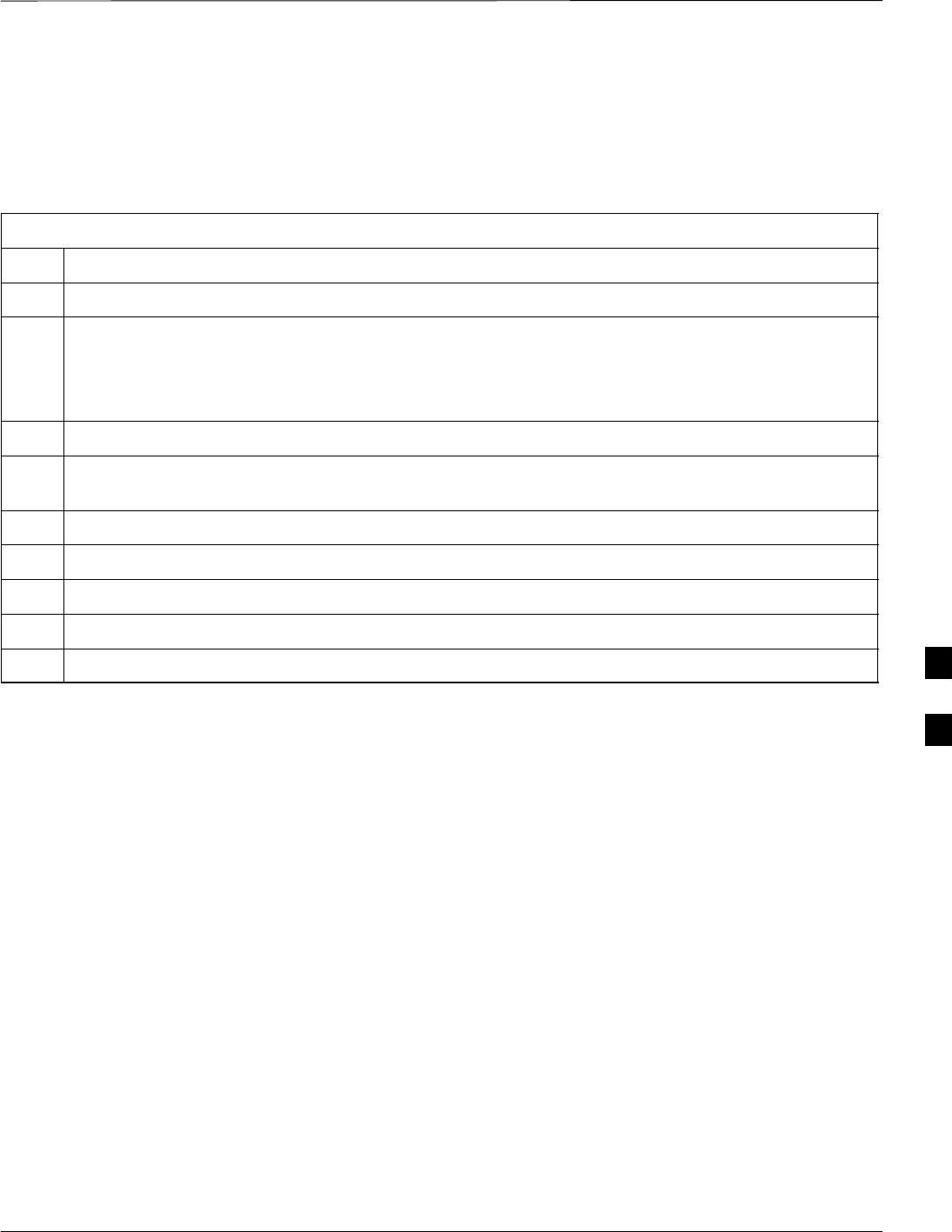
Logical BTS LAN Configuration for Compact BTS (Indoor) – continued
Jun 2004 1X SC480 BTS Hardware Installation, Optimization/ATP, and FRU F-3
DRAFT
Logical BTS LAN Cabling
Installation Procedure
Follow the procedure in Table F-1 for installation of LAN cables for
Logical BTS.
Table F-1: Procedure for Installing LAN Cabling for Logical BTS
Step Action
1Follow the procedure in Chapter 4 for installing a Compact BTS in a rack.
2For a 3 BTS expansion configuration, follow Figure F-1. Proceed to step 3.
2a For a 2 BTS expansion configuration, follow Figure F-2. Proceed to step 3.
2b For a 1 BTS expansion configuration, follow Figure F-3. Proceed to step 3.
3Route LAN cables through conduit from Starter to Expansion BTS 1.
4Route LAN cables through conduit from Starter to Expansion BTS 2 or 3 (depending on
configuration).
5If in use, route LAN cables from Expansion BTS 1 to Expansion BTS 2.
6If in use, route LAN cables from Expansion BTS 2 to Expansion BTS 3.
7Ensure that unused LAN connections are terminated in 50 ohms.
8If not already performed, proceed to Appendix E for expansion cabling diagrams.
9Perform Optimization and ATP as described in Chapter 6. LMF Help provides further information.
F

Logical BTS LAN Configuration for Compact BTS (Indoor) – continued
F-4 1X SC480 BTS Hardware Installation, Optimization/ATP, and FRU Jun 2004
DRAFT
Notes
F

Jun 2004 1X SC480 BTS Hardware Installation, Optimization/ATP, and FRU
DRAFT
Appendix G: Integrated BTS Router Preliminary Operations
Appendix Content
Integrated BTS Router Preliminary Operations – Introduction G-1 . . . . . . . . . . . . .
Introduction G-1 . . . . . . . . . . . . . . . . . . . . . . . . . . . . . . . . . . . . . . . . . . . . . .
Preliminary Operations G-1 . . . . . . . . . . . . . . . . . . . . . . . . . . . . . . . . . . . . .
When to Perform the Verifications G-1 . . . . . . . . . . . . . . . . . . . . . . . . . . . .
Verify GLI3 Software Version and Span Parameter Settings G-2 . . . . . . . . . . . . . . .
Verify GLI3 Software Version and Span Parameter Settings G-2 . . . . . . . .
Required Items G-2 . . . . . . . . . . . . . . . . . . . . . . . . . . . . . . . . . . . . . . . . . . . .
Verifying GLI3 Software Version and Span Parameter Settings G-2 . . . . . .
Change GLI3 Span Parameter Settings G-6 . . . . . . . . . . . . . . . . . . . . . . . . . . . . . . .
Change GLI3 Span Parameter Configuration G-6 . . . . . . . . . . . . . . . . . . . .
G

Table of Contents – continued
1X SC480 BTS Hardware Installation, Optimization/ATP, and FRU Jun 2004
DRAFT
Notes
G

Integrated BTS Router Preliminary Operations – Introduction
Jun 2004 1X SC480 BTS Hardware Installation, Optimization/ATP, and FRU G-1
DRAFT
Introduction
The information and procedures provided are performed in cases where
the GLI3 load and span parameters need to be verified.
Preliminary Operations
Implementing the Integrated BTS Router (IBR) function requires some
preliminary checks of the GLI3 cards which will be used. This appendix
provides the procedures to accomplish these checks. The checks are:
SVerification that IBR–capable software is installed on GLI3 cards
which will be used for IBR
SVerification that span parameter settings on GLI3 cards match the
requirement for the spans at the BTS where the cards will be installed.
When to Perform the
Verifications
All preliminary verifications provided in this chapter can be performed
at either the BTS site or in a central facility equipped to power–up the
GLI3 cards. Depending on the circumstances of the cards’ use, however,
it may be advantageous in reducing the on–site upgrade time and
logistics to perform some of the verifications prior to installation at the
BTS site. Table G-1 lists card conditions of use and the corresponding
suggested verification locations for the software version and span
parameter settings.
Table G-1: Suggested Preliminary Verification Locations
GLI3 Card Condition Installation
Location Software Version
Verification
Location
Span Parameter
Settings Verification
Location
Installed and operating
(circuit or packet) Site where installed At site Not required unless
span type will
change
Different operating
site from where
currently installed
At site where
currently installed Before or after
installation at
different site
G

Verify GLI3 Software Version and Span Parameter Settings
G-2 1X SC480 BTS Hardware Installation, Optimization/ATP, and FRU Jun 2004
DRAFT
Verify GLI3 Software Version
and Span Parameter Settings
Software Version Verification – Before upgrading a BTS to packet
backhaul with an IBR, the software version installed in the GLI3 card or
cards must be verified. If the installed software version does not support
IBR functionality, it must be upgraded to a version which does. For BTS
sites which are already in operation, the upgrade can be done through a
network download to the GLI3 once it is installed. For cards to be
installed in new BTS sites not previously in operation, the upgrade
requires special procedures, and must be done with Motorola Field
Operations or Account Team assistance.
Span Parameter Settings – Prior to initializing a GLI3 card for the first
time in a live circuit BTS or IBR packet BTS site, the span parameter
settings in the card must be verified as matching those provisioned in the
OMC–R database. If the settings are not correct, the card will be unable
to communicate with the RAN network elements and the site will not go
into service. Procedures are included in this section to change the GLI3
card span parameter settings if this is necessary to match those required
for the BTS.
Required Items
The following items are required to perform the verification:
SLocal Maintenance Facility (LMF) computer with the LMF
application program version installed which is compatible with the
software release installed on the BSS refer to Chapter 6
Optimization/ATP in this manual.
SOne of the following
– Motorola cable part number CGDSMMICABLE219112
– Fabricated DB–9 receptacle–to–8–contact MMI connector cable
(see the MMI Cable Fabrication Section of Appendix D for
fabrication instructions and Figure 6-9 for connection)
– SLN2006A MMI Interface Kit (this kit is no longer available to
order), consisting of the following:
–– Motorola Model TRN9666A null modem board
–– Motorola 3009786R01 MMI cable or equivalent
S(For use with SLN2006A only) Straight–through RS–232 cable,
DB–9 to DB–9, and DB–9 to DB–25 connector adapter (see
Figure D-1)
Verifying GLI3 Software
Version and Span Parameter
Settings
Follow the procedure in Table G-2 to verify GLI3 card software version
and span parameter settings.
G

Verify GLI3 Software Version and Span Parameter Settings – continued
Jun 2004 1X SC480 BTS Hardware Installation, Optimization/ATP, and FRU G-3
DRAFT
Table G-2: Verify GLI3 Software Version and Span Parameter Settings
Step Action
1If it has not been done, start a GLI3 MMI communication session on the LMF computer as described
in Table 6-11.
2Verify the installed software version by entering the following at the GLI3 prompt:
display version
3Response to the command will depend on the operating mode of the card. Responses similar to the
following will be displayed for:
3a – Cards in circuit mode:
GLI3> display version
01.09.1980 20:01:59 MGLI–002–2 OOS–SBY BTS–CDMA 16.41.200.14
RAM version: 16.41.200.14
ROM version: 16.41.200.14
Built: Tue Oct 21 09:52:28 2003 il27–2112
Bootrom version: 16.41.200.12
Bootrom Built: Thu Oct 2 03:11:34 2003 IL27–0775
Bootblock version: 16.1.59.00
Bootblock Built: Wed Apr 10 07:08:06 2002 RIPCORD004
This GLI board is in RAM
Booted from /nvram00/loads/gli3_ckt_rom_upgrade.elf
Next boot from /nvram00/loads/gli3_ckt_rom_upgrade.elf
GLI3>
. . . continued on next page G

Verify GLI3 Software Version and Span Parameter Settings – continued
G-4 1X SC480 BTS Hardware Installation, Optimization/ATP, and FRU Jun 2004
DRAFT
Table G-2: Verify GLI3 Software Version and Span Parameter Settings
Step Action
3b – For cards in packet mode:
GLI3> display version
03.23.2004 18:16:07 MGLI–250–1 CC PRESENT BTS–CDMA 16.41.00.11
INTERNAL RAM VERSION: 16.41.0.11
RAM Built: Tue Mar 2 04:59:33 2004 il27–2112
BOOTROM VERSION: 16.41.00.08
BOOTROM Built: Tue Feb 17 10:52:27 2004 il27–0507
BOOTBLOCK VERSION: 16.1.59.00
BOOTBLOCK Built: Wed Apr 10 07:08:06 2002 RIPCORD004
SYSTEM VERSION: 2.16.4.50.15
COMMITTED VERSION: 2.16.4.50.15
NEXT VERSION: 2.16.4.50.15
BACK UP VERSION 2.16.4.50.10
CURRENT RELEASE PATH: /nvram00/screl/2.16.4.50.15/
CURRENT LIF: /nvram00/screl/2.16.4.50.15/NE_LIF.xml
CURRENT IMAGE: /nvram00/screl/2.16.4.50.15/gli_ram.bin.0108
CODE SERVER: 128.0.0.1
GLI3>
4Note the bootROM or System version numbers displayed and determine if the GLI3 is loaded with
IBR–capable code as follows:
SIf the booROM version number is 2.16.41.00.08 or later, the GLI3 is IBR–capable
SIf the System version number is 2.16.4.50.7 or later (for example, 2.16.4.50.25), the GLI3 is
IBR–capable
NOTE
If the card is to be installed in a new BTS site which has not previously been in operation, contact the
local Motorola Account Team for assistance in upgrading the card with IBR–capable software version.
. . . continued on next page
G
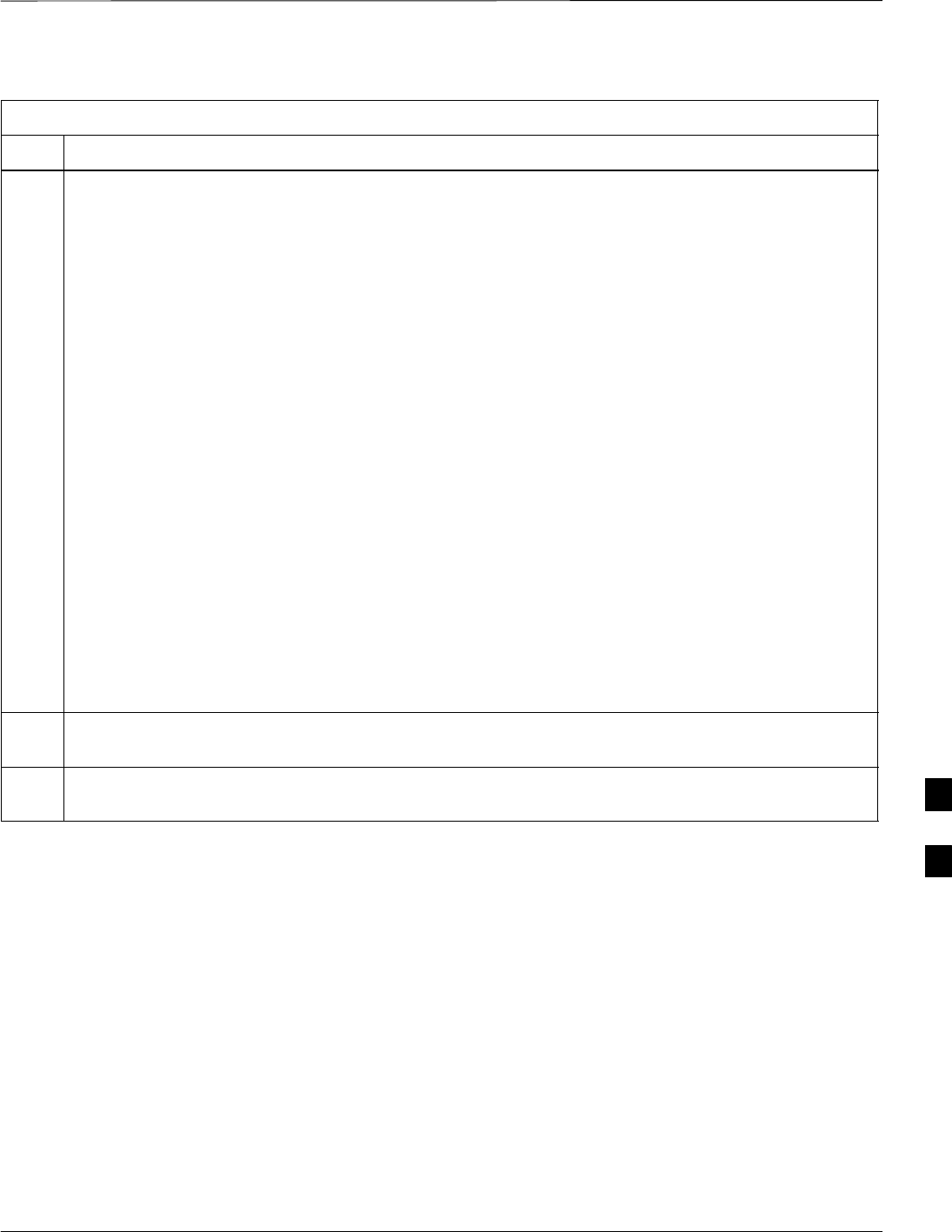
Verify GLI3 Software Version and Span Parameter Settings – continued
Jun 2004 1X SC480 BTS Hardware Installation, Optimization/ATP, and FRU G-5
DRAFT
Table G-2: Verify GLI3 Software Version and Span Parameter Settings
Step Action
5Verify the span parameter settings for frame format, equalization, and linkspeed by entering the
following at the GLI3> prompt:
config ni current
The system will respond with a display similar to the following:
The frame format in flash is set to use T1_2.
Equalization:
Span A – Default (0–131 feet for T1/J1, 120 Ohm for E1)
Span B – Default (0–131 feet for T1/J1, 120 Ohm for E1)
Span C – Default (0–131 feet for T1/J1, 120 Ohm for E1)
Span D – Default (0–131 feet for T1/J1, 120 Ohm for E1)
Span E – Default (0–131 feet for T1/J1, 120 Ohm for E1)
Span F – Default (0–131 feet for T1/J1, 120 Ohm for E1)
Linkspeed: Default (56K for T1 D4 AMI, 64K otherwise)
Currently, the link is running at the default rate
The actual rate is 0
NOTE
SDefaults for span equalization are 0–131 feet for T1/J1 spans and 120 Ohm for E1.
SDefault linkspeed is 56K for T1 D4 AMI spans and 64K for all other types.
SThere is no need to change from defaults unless the provisioned span configuration requires it.
6The span parameter settings in the GLI must match those provisioned in the OMC–R database for the
BTS. If they do not, proceed to Table G-3 in the Change GLI3 Span Parameter Settings section.
7If no other MMI actions are required for the card, terminate the MMI communication session and
disconnect the LMF computer from the card.
G

Change GLI3 Span Parameter Settings
G-6 1X SC480 BTS Hardware Installation, Optimization/ATP, and FRU Jun 2004
DRAFT
Change GLI3 Span Parameter
Configuration
If span parameter settings in the GLI3 card do not match the OMC–R
database span parameters for the BTS where they are to be installed,
follow the procedure in Table G-3 to change them.
Table G-3: Set GLI3 Span Parameter Configuration
Step Action
1If it has not been done, start a GLI3 MMI communication session on the LMF computer as described
in Table 6-11.
2At the GLI3> prompt, enter the following:
config ni format
The terminal will display a response similar to the following:
COMMAND SYNTAX: config ni format option
Next available options:
LIST – option : Span Option
E1_1 : E1_1 – E1 HDB3 CRC4 no TS16
E1_2 : E1_2 – E1 HDB3 no CRC4 no TS16
E1_3 : E1_3 – E1 HDB3 CRC4 TS16
E1_4 : E1_4 – E1 HDB3 no CRC4 TS16
T1_1 : T1_1 – D4, AMI, No ZCS
T1_2 : T1_2 – ESF, B8ZS
J1_1 : J1_1 – ESF, B8ZS (Japan) – Default
J1_2 : J1_2 – ESF, B8ZS
T1_3 : T1_3 – D4, AMI, ZCS
>
NOTE
With this command, all active (in–use) spans will be set to the same format.
3To set or change the span type, enter the correct option from the list at the entry prompt (>), as shown
in the following example:
> T1_2
NOTE
The entry is case–sensitive and must be typed exactly as it appears in the list. If the entry is typed
incorrectly, a response similar to the following will be displayed:
CP: Invalid command
01.061980 00:11’59 MGLI–000–2 INS–ACT BTS–CDMA 16.1.68.00
GLI3>
. . . continued on next page
G

Change GLI3 Span Parameter Settings – continued
Jun 2004 1X SC480 BTS Hardware Installation, Optimization/ATP, and FRU G-7
DRAFT
Table G-3: Set GLI3 Span Parameter Configuration
Step Action
4An acknowledgement similar to the following will be displayed:
The value has been programmed. It will take effect after the next reset.
GLI3>
5If the current GLI span rate must be changed, enter the following MMI command:
config ni linkspeed
A response similar to the following will be displayed :
Next available options:
LIST – linkspeed : Span Linkspeed
56K : 56K (default for T1_1 and T1_3 systems)
64K : 64K (default for all other span configurations)
>
NOTE
With this command, all active (in–use) spans will be set to the same linkspeed.
6To set or change the span linkspeed, enter the required option from the list at the entry prompt (>), as
shown in the following example:
> 64K
NOTE
The entry is case–sensitive and must be typed exactly as it appears in the list. If the entry is typed
incorrectly, a response similar to the following will be displayed:
CP: Invalid command
01.061980 00:12’04 MGLI–000–2 INS–ACT BTS–CDMA 16.1.68.00
GLI3>
7An acknowledgement similar to the following will be displayed:
The value has been programmed. It will take effect after the next reset.
GLI3>
. . . continued on next page
G

Change GLI3 Span Parameter Settings – continued
G-8 1X SC480 BTS Hardware Installation, Optimization/ATP, and FRU Jun 2004
DRAFT
Table G-3: Set GLI3 Span Parameter Configuration
Step Action
8If the span equalization must be changed, enter the following MMI command:
config ni equal
A response similar to the following will be displayed:
COMMAND SYNTAX: config ni equal span equal
Next available options:
LIST – span : Span
a : Span A
b : Span B
c : Span C
d : Span D
e : Span E
f : Span F
>
. . . continued on next page
G

Change GLI3 Span Parameter Settings – continued
Jun 2004 1X SC480 BTS Hardware Installation, Optimization/ATP, and FRU G-9
DRAFT
Table G-3: Set GLI3 Span Parameter Configuration
Step Action
9At the entry prompt (>), enter the designator from the list for the span to be changed as shown in the
following example:
> a
A response similar to the following will be displayed :
COMMAND SYNTAX: config ni equal a equal
Next available options:
LIST – equal : Span Equalization
0 : 0–131 feet (default for T1/J1)
1 : 132–262 feet
2 : 263–393 feet
3 : 394–524 feet
4 : 525–655 feet
5 : LONG HAUL
6 : 75 OHM
7 : 120 OHM (default for E1)
8 : T1 Long Haul mode. No Attenuation
9 : T1 Long Haul mode. 7.5 dB Attenuation
10 : T1 Long Haul mode. 15.0 dB Attenuation
11 : T1 Long Haul mode. 22.5 dB Attenuation
12 : E1 Long Haul mode.
>
! CAUTION
When selecting span equalization settings, comply with the following or the BTS may operate
erratically or unpredictably:
SFor ALL BTS types, do not select any of the following settings if they are displayed:
– 5 LONG HAUL
– 6 75 OHM
– 11 T1 Long Haul mode. 22.5 dB Attenuation
– 12 E1 Long Haul mode
SFor four–digit BTSs supported with Channel Service Units (CSU), do not select any of the
following additional settings:
– 8 T1 Long Haul mode. No Attenuation
– 9 T1 Long Haul mode. 7.5 dB Attenuation
– 10 T1 Long Haul mode. 15.0 dB Attenuation
. . . continued on next page
G

Change GLI3 Span Parameter Settings – continued
G-10 1X SC480 BTS Hardware Installation, Optimization/ATP, and FRU Jun 2004
DRAFT
Table G-3: Set GLI3 Span Parameter Configuration
Step Action
10 At the entry prompt (>), enter the code for the required equalization from the list as shown in the
following example:
> 0
A response similar to the following will be displayed :
> 0
The value has been programmed. It will take effect after the next reset.
GLI2>
11 Repeat steps 8 through 10 for each in–use span.
12 NOTE
This step must be performed for GLI3 cards operating on a packet image to ensure the span parameter
changes will replace the previous settings.
For a GLI3 card in packet mode, enter the following:
rmfile /nvram00/config/hlp_param.txt
A response similar to the following will be displayed :
GLI3> rmfile /nvram00/config/hlp_param.txt
11.24.2003 23:14:57 MGLI–004–1 CC PRESENT BTS–CDMA 16.40.00.09
Removing file: /nvram00/config/hlp_param.txt
Successfully removed file: /nvram00/config/hlp_param.txt
GLI3>
13 * IMPORTANT
SAfter executing the config ni format, config ni linkspeed, and/or config ni equal commands,
the affected MGLI/GLI board MUST be reset and reloaded for changes to take effect.
SAlthough defaults are shown in the software, always consult site–specific documentation for span
type, equalization, and linkspeed used at the site where the cards are to be installed.
Reset the card using the MMI reset command.
. . . continued on next page
G
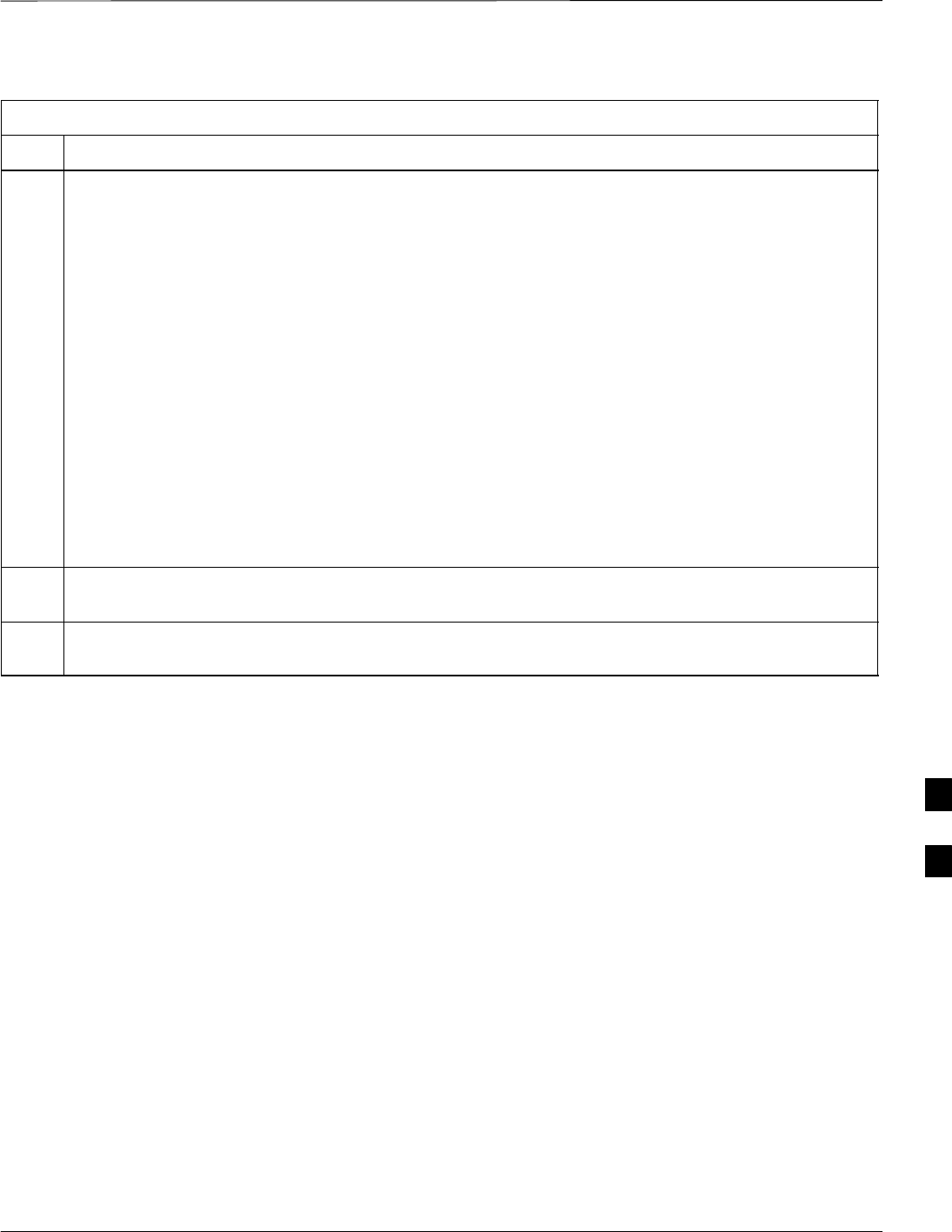
Change GLI3 Span Parameter Settings – continued
Jun 2004 1X SC480 BTS Hardware Installation, Optimization/ATP, and FRU G-11
DRAFT
Table G-3: Set GLI3 Span Parameter Configuration
Step Action
14 Once the card has completed resetting, execute the following command to verify span settings are as
required:
config ni current
A response similar to the following will be displayed :
The frame format in flash is set to use T1_2.
Equalization:
Span A – 0–131 feet
Span B – 0–131 feet
Span C – Default (0–131 feet for T1/J1, 120 Ohm for E1)
Span D – Default (0–131 feet for T1/J1, 120 Ohm for E1)
Span E – Default (0–131 feet for T1/J1, 120 Ohm for E1)
Span F – Default (0–131 feet for T1/J1, 120 Ohm for E1)
Linkspeed: 64K
Currently, the link is running at 64K
The actual rate is 0
15 If the span configuration is not correct, perform the applicable step from this table to change it and
repeat steps 12, 13, and 14 to verify required changes have been programmed.
16 If no other MMI actions are required for the card, terminate the MMI communication session and
disconnect the LMF computer from the card.
G

Change GLI3 Span Parameter Settings – continued
G-12 1X SC480 BTS Hardware Installation, Optimization/ATP, and FRU Jun 2004
DRAFT
Notes
G

Jun 2004 1X SC480 BTS Hardware Installation, Optimization/ATP, and FRU
DRAFT
Appendix H: Integrated BTS Router Installation
Appendix Content
Integrated BTS Router Installation – Introduction H-1 . . . . . . . . . . . . . . . . . . . . . . .
Background H-1 . . . . . . . . . . . . . . . . . . . . . . . . . . . . . . . . . . . . . . . . . . . . . .
New Packet BTS Installation with IBR H-2 . . . . . . . . . . . . . . . . . . . . . . . . . . . . . . .
New Packet BTS Installation H-2 . . . . . . . . . . . . . . . . . . . . . . . . . . . . . . . . .
Prerequisites H-2 . . . . . . . . . . . . . . . . . . . . . . . . . . . . . . . . . . . . . . . . . . . . . .
Implementing IBR Functionality H-2 . . . . . . . . . . . . . . . . . . . . . . . . . . . . . .
BTS Span Connections for IBR H-4 . . . . . . . . . . . . . . . . . . . . . . . . . . . . . . . . . . . . .
BTS Span Connections H-4 . . . . . . . . . . . . . . . . . . . . . . . . . . . . . . . . . . . . .
BTS Span Cable H-4 . . . . . . . . . . . . . . . . . . . . . . . . . . . . . . . . . . . . . . . . . . .
BTS Span Connections for IBR – One Span H-5 . . . . . . . . . . . . . . . . . . . . . . . . . . .
One Span Frame H-5 . . . . . . . . . . . . . . . . . . . . . . . . . . . . . . . . . . . . . . . . . .
H

Table of Contents – continued
1X SC480 BTS Hardware Installation, Optimization/ATP, and FRU Jun 2004
DRAFT
Notes
H

Integrated BTS Router Installation – Introduction
Jun 2004 1X SC480 BTS Hardware Installation, Optimization/ATP, and FRU H-1
DRAFT
Background
The IBR capability was developed to provide a low–cost solution for
providing CDMA packet backhaul benefits at cell sites with lower traffic
volumes. The IBR function is implemented by using the GLI3 card
Concentration Highway Interface (CHI) bus 2 processor to perform the
router function. This is accomplished through changes in the GLI3 card
software. A card with the IBR–capable software can perform as a circuit
GLI3 card, as a GLI3 with IBR, and as a GLI3 used with external BTS
router groups. The card has the capability to recognize the environment
in which it is installed and autoselect the appropriate operating mode
(circuit, IBR packet, external BTS router packet).
Span line channel capability for an IBR–equipped SC480 BTS is limited
to those available on a single T1 or E1 span.
H

New Packet BTS Installation with IBR
H-2 1X SC480 BTS Hardware Installation, Optimization/ATP, and FRU Jun 2004
DRAFT
New Packet BTS Installation
This section covers the actions necessary for implementing IBR packet
capability in the installation of a new BTS. Procedures unique to this
implementation are contained in this section. When procedures required
in this implementation are contained in other parts of this publication or
in other publications, the user will be specifically directed to them at the
appropriate places in this section.
Prerequisites
The following must be accomplished prior to traveling to the BTS site
for IBR implementation:
SThe BTS has been installed as described in Chapter 4 of this manual.
SOne of the following:
– GLI3 card(s) for the site have been verified as having IBR–capable
software image installed
– Motorola Field Operations or Account Team member is identified
to travel to the BTS site to perform GLI3 IBR–capable software
installation, if required
SGLI3 card(s) for the BTS are on hand for transport to the BTS site or
are verified to be at the BTS site
SRequired publications to support IBR implementation activities are on
hand for transportation to the BTS site
Implementing IBR Functionality
Follow the procedure in Table H-1 to implement IBR functionality for
the BTS.
Table H-1: Implement IBR Functionality in New BTS
Step Action
1Upon arrival at the site, contact the OMC–R and notify the operator that site operations are starting.
2If the BTS has not been initially powered up, apply power to the BTS in accordance with the Power
Pre–Power–up Tests and Initial Power–up Tests and Procedures described in Chapter 5 of this manual.
3Once the BTS is fully powered up with these procedures, the GLI3 card should have been seated in the
correct slot. If it is not, seat the card at this time and allow each to complete its initialization.
4If it was not previously done, follow the procedure in Table G-2 to:
SVerify the software version in the GLI3 card(s)
SVerify the span parameter settings in each GLI3 card match those established for the site in the
OMC–R database
5If the GLI3software requires upgrading for IBR capability, request Motorola Field Operations or
Account Team assistance in upgrading the software.
6If GLI3 card span parameter settings do not match those required, change them as necessary by
following the procedure in Table G-3.
. . . continued on next page
H
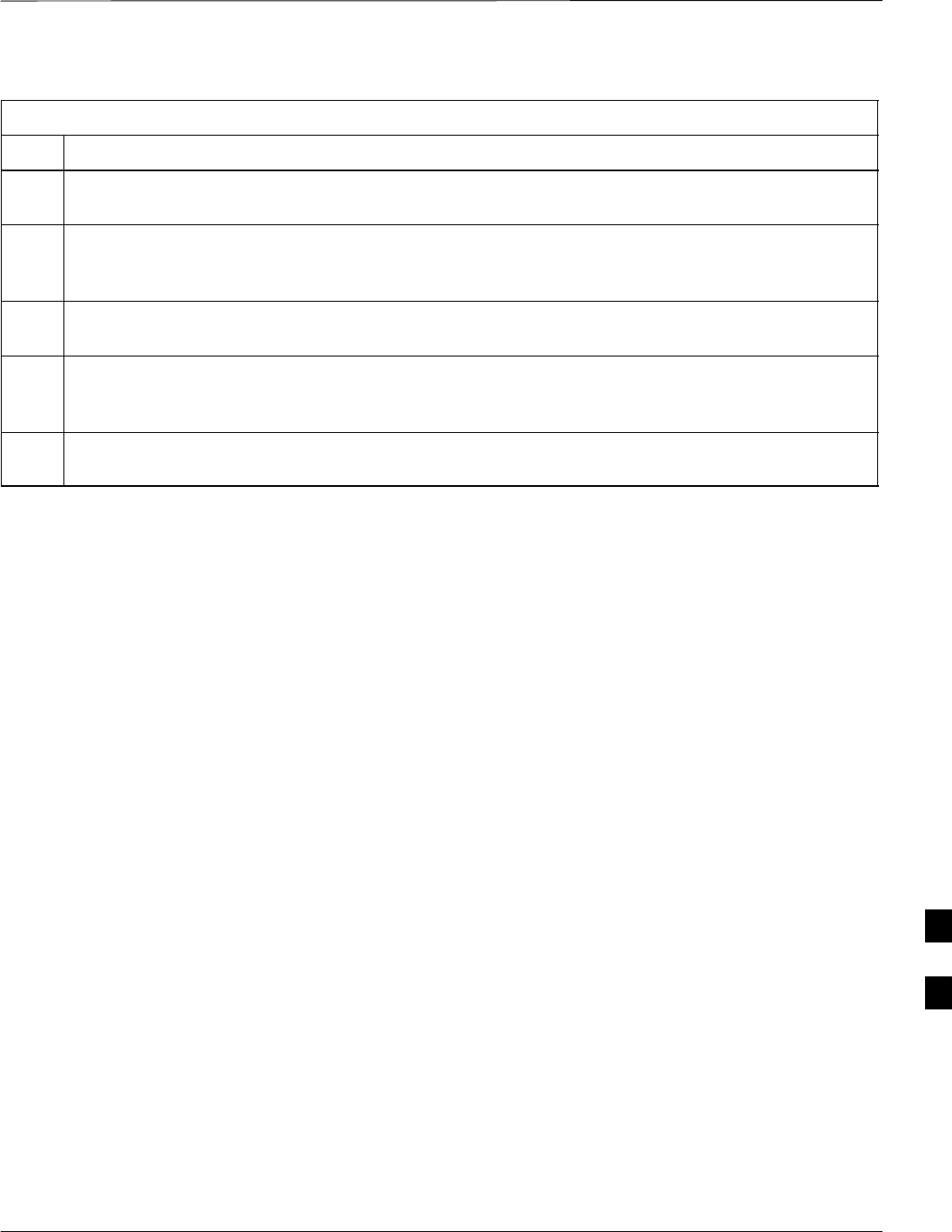
New Packet BTS Installation with IBR – continued
Jun 2004 1X SC480 BTS Hardware Installation, Optimization/ATP, and FRU H-3
DRAFT
Table H-1: Implement IBR Functionality in New BTS
Step Action
7Refer to the site documentation for IBR spans and inspect the BTS span cabling connections to be sure
they match Figure H-1.
8Correct any cabling discrepancies between the BTS span cabling and site documentation, referring to
Figure H-1 and the Install Span and Alarm Cables and Span Line Cable Pin Numbering Chapter 4 of
this manual as required.
9If the BTS requires optimization and/or ATP, perform them at this time by following the applicable
procedures in Chapter 6 of this manual.
10 When all preparations for BTS operation are completed, contact the OMC–R and notify the operator
that the BTS is ready for operation and request notification when the operator no longer requires
support on–site.
11 When advised that there is no further requirement for on–site support of BTS and IBR initialization,
proceed to Chapter 8 and follow the procedures to prepare to leave the site.
H
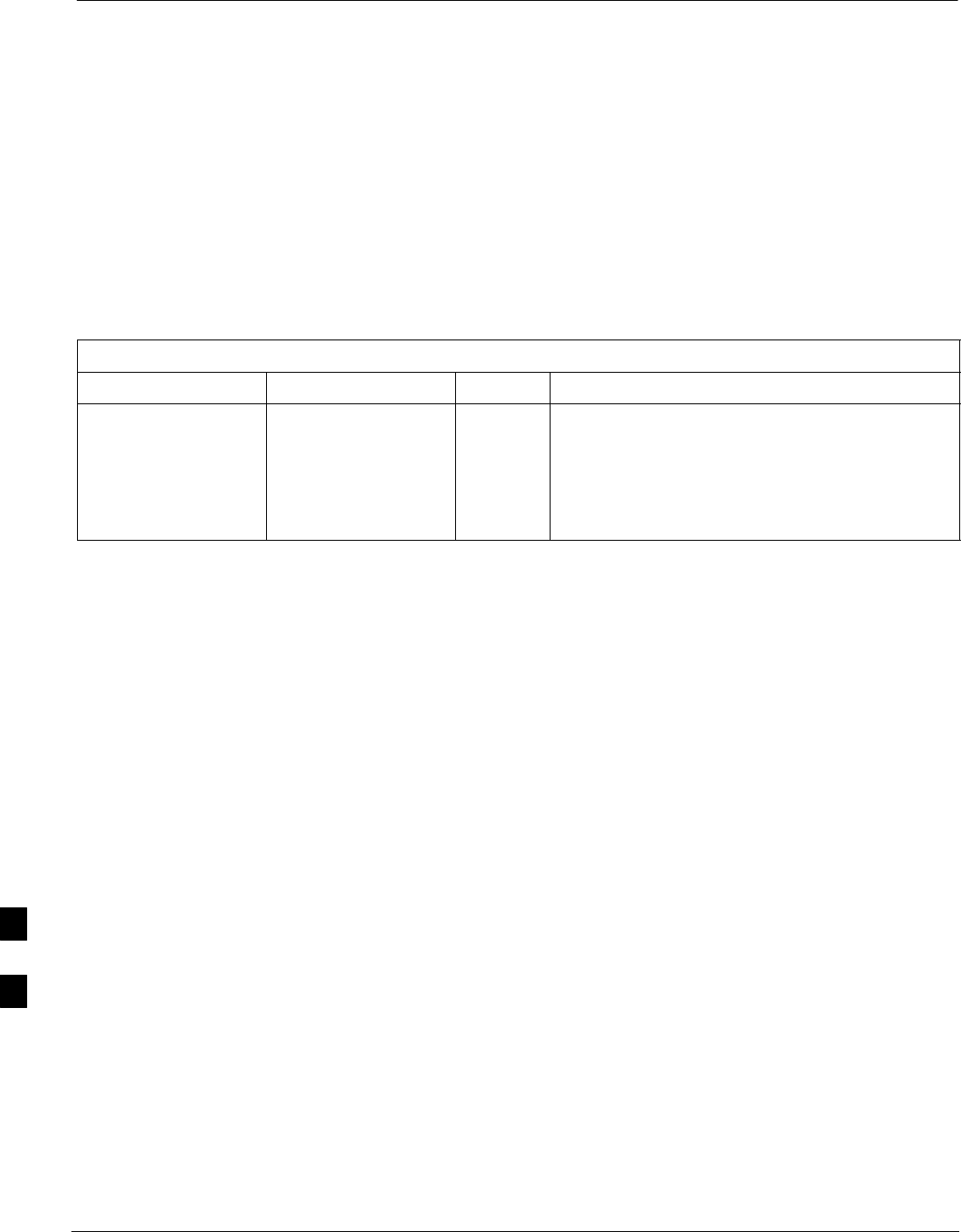
BTS Span Connections for IBR
H-4 1X SC480 BTS Hardware Installation, Optimization/ATP, and FRU Jun 2004
DRAFT
BTS Span Connections
The illustration in this section provides the detail of span connection for
a non–redundant BTS to support IBR packet operation. The required
configuration for IBR in redundant BTS is a single span.
BTS Span Cable
All connections in the BTS span connection diagram for IBR are based
on the use of the following Motorola–standard BTS span cable:
Table H-2: BTS Span Cables
Item Part Number Qty Description
BTS span cable CGDS1583461
or
CGDS1583462
1Cable, 50–wire, shielded twisted 25 pair, 100
ohm, 24–AWG, 7.6 m (25 ft – CGDS1583461) or
15.2 m (50 ft – CGDS1583462), one male
50–contact TELCO connector attached. One end
of cable is un–terminated to allow connection to
site termination equipment.
H
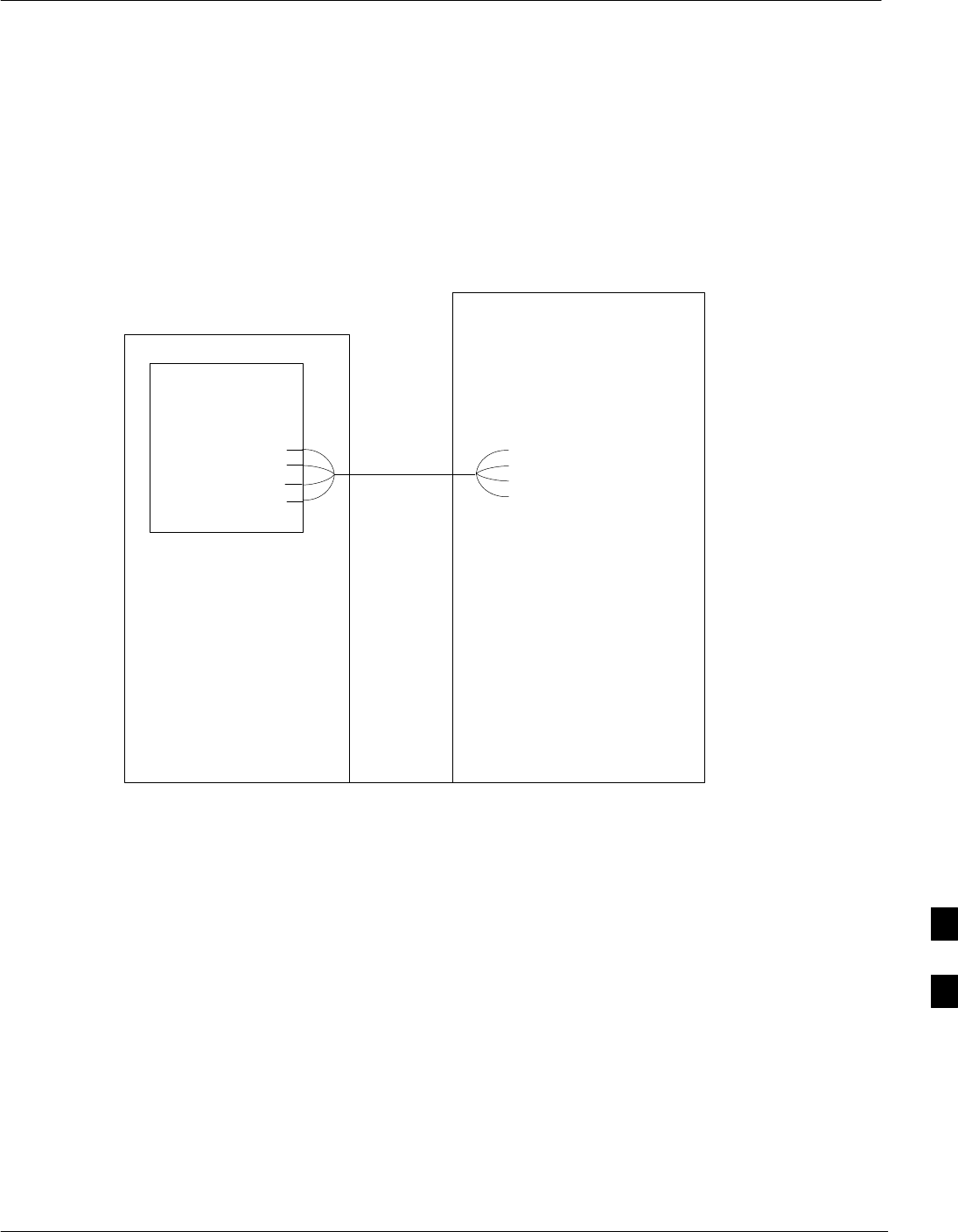
BTS Span Connections for IBR – One Span
Jun 2004 1X SC480 BTS Hardware Installation, Optimization/ATP, and FRU H-5
DRAFT
One Span Frame
Figure H-1 illustrates the connection details for one span to support
packet operation with IBR for non–redundant BTS.
Figure H-1: Cabling Compact BTS Packet Operation Integrated BTS Router Spans –
One Span
BTS Termination
Equipment
ALL CROSS–CONNECTS
ARE DONE WITHIN
TERMINATION
EQUIPMENT
SC4812TL0201
PIN 2 RX TIP A
PIN 1 RX RING A
PIN 5 TX TIP A
PIN 4 TX RING A
SPAN I/O A
BTS SPAN
CABLE
ORG–WHT TX TIP
WHT–ORG TX RING
BLU–WHT RX TIP
WHT–BLU RX RING
H

BTS Span Connections for IBR – One Span – continued
H-6 1X SC480 BTS Hardware Installation, Optimization/ATP, and FRU Jun 2004
DRAFT
Notes
H

Jun 2004 1X SC480 BTS Hardware Installation, Optimization/ATP, and FRU
DRAFT
Appendix I: Packet Backhaul Configuration
Appendix Content
Packet Backhaul BTS I-1 . . . . . . . . . . . . . . . . . . . . . . . . . . . . . . . . . . . . . . . . . . . .
Introduction I-1 . . . . . . . . . . . . . . . . . . . . . . . . . . . . . . . . . . . . . . . . . . . . . .
Packet Backhaul BTS Procedures I-1 . . . . . . . . . . . . . . . . . . . . . . . . . . . . .
I

Table of Contents – continued
1X SC480 BTS Hardware Installation, Optimization/ATP, and FRU Jun 2004
DRAFT
Notes
I

Packet Backhaul BTS
Jun 2004 1X SC480 BTS Hardware Installation, Optimization/ATP, and FRU I-1
DRAFT
Introduction
For Packet Backhaul, the LMF Help should be accessed for the
appropriate procedures.
Packet Backhaul BTS
Procedures
Optimization Procedures
SClick on LMF Help
SSelect Optimization/ATP Process
SSelect Optimization procedure for SC48X
– Important CDF Parameters
– CSA
– Optimization of SC48X High Power Configuration
– Optimization of SC48X Low Power Configuration
– Optimization of SC48X High Power in Logical Configuration
– Optimization of SC48X Low Power in Logical Configuration
– Calibrating Procedures for SC48X Expansion Frame Configurations
Follow the appropriate procedure identified in the LMF Help.
I

Packet Backhaul BTS – continued
I-2 1X SC480 BTS Hardware Installation, Optimization/ATP, and FRU Jun 2004
DRAFT
Notes
I

Jun 2004 1X SC480 BTS Hardware Installation, Optimization/ATP, and FRU
DRAFT
Appendix J: Highway Cell Configuration
Appendix Content
BTS for Highway Cell Configuration J-1 . . . . . . . . . . . . . . . . . . . . . . . . . . . . . . . .
Introduction J-1 . . . . . . . . . . . . . . . . . . . . . . . . . . . . . . . . . . . . . . . . . . . . . .
Highway Cell Configuration J-1 . . . . . . . . . . . . . . . . . . . . . . . . . . . . . . . . .
J

Table of Contents – continued
1X SC480 BTS Hardware Installation, Optimization/ATP, and FRU Jun 2004
DRAFT
Notes
J

BTS for Highway Cell Configuration
Jun 2004 1X SC480 BTS Hardware Installation, Optimization/ATP, and FRU J-1
DRAFT
Introduction
The highway cell configuration is a 1 carrier, two sector with no RX
diversity and one duplexed antenna. The configuration is for 1.9 GHz
and +27 V.
The 1.9 GHz, +27V A & B–Band does not support highway
configuration.
Highway Cell Configuration
Figure J-1 shows a typical highway cell configuration.
DC power may be provided by a +27V Power Distribution Enclosure or
other equivalent power source.
Units may be pole or wall mounted. Type of mounting used is
determined by the customer.
J
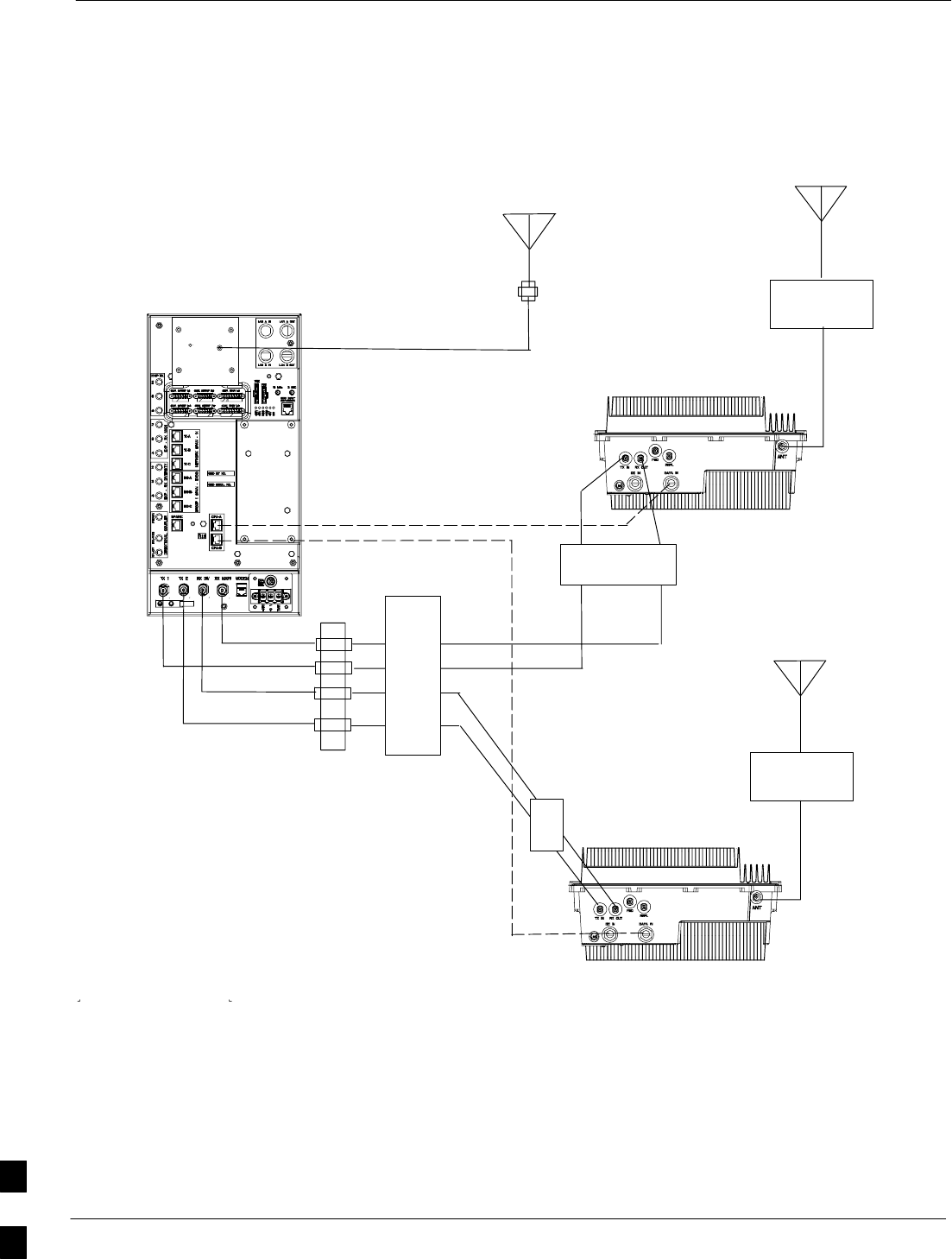
BTS for Highway Cell Configuration – continued
J-2 1X SC480 BTS Hardware Installation, Optimization/ATP, and FRU Jun 2004
DRAFT
LIGHTNING
ARRESTOR
LIGHTNING
ARRESTOR
STARTER
cCLPA 1
cCLPA 2
LOCAL GPS
TME
RF–GPS
CONNECTOR
TX1
RX MAIN
RX DIV
TX2
TME ANTENNA
CONNECTORS
Power and Ground not shown
Figure J-1: Typical Highway Cell Configuration Diagram
SAs
SURGE
ARRESTORS
SAs
J

Jun 2004 1X SC480 BTS Hardware Installation, Optimization/ATP, and FRU Index-1
DRAFT
Index
Numbers
10BaseT/10Base2 converter, LMF to BTS
connection, 6-17
A
Abbreviated
RX acceptance test, all–inclusive, 7-5
TX acceptance test, all–inclusive, 7-5
Acceptance Test Procedure. See ATP
Accessing OMCR CLI Window, 10-2
Advantest R3267 Spectrum Analyzer GPIB Address,
B-7
Advantest R3465 Communications Test Set GPIB
Address, B-12
Advantest R3562 Signal Generator GPIB Address,
B-9
Agilent 8935 Series E6380 (formerly HP 8935) Test
Set GPIB Address, B-9
Agilent E4406A, calibration, B-28
Agilent E4406A Transmitter Tester GPIB Address,
B-5
Agilent E4432B Signal Generator GPIB Address, B-6
All Cal/Audit procedure, 6-82
All RX ATP Test Procedure, 7-8
All TX ATP Test Procedure, 7-7
All TX/RX ATP Test Procedure, 7-6
ATP
all inclusive TX acceptance test outline, 7-5
automated introduction, 7-1
code domain noise floor acceptance test procedure,
7-19
code domain power acceptance test procedure, 7-19
failure report generation, 7-23
FER test, frame error rate testing, 7-21
pilot time offset, 7-16
prerequisites, 7-2
spectral purity TX mask, 7-11
test set–up, 6-61
Advantest R3267/R3562, DRDCs, 6-64
Advantest R3465, 6-61
Agilent 8935, DRDCs, 6-61
Agilent 8935/E4432B, DRDCs, 6-63
Agilent E4406A/E4432B, DRDCs, 6-63
CyberTest, 6-61
HP 8921A, 1.9 GHz, 6-62
HP 8921A, 800 MHz, 6-59 , 6-62
waveform quality (Rho), 7-14
waveform quality (RHO) acceptance test procedure,
7-14
ATP – Reduced, 7-1
Attenuator, required test equipment, 1-20
B
Basic Troubleshooting Overview, 11-1
Bay Level Offset calibration
description, 6-76
purpose, 6-76
when to calibrate, 6-76
BBX
carrier spectral purity, 7-11
primary and redundant, TX tests to be performed,
7-9
BLO. See Bay Level Offset calibration
Broad Band Receiver. See BBX
BTS
download, 6-36
Ethernet LAN interconnect diagram, 6-33
LMF connection, 6-16 , 6-17

Index – continued
Index-2 1X SC480 BTS Hardware Installation, Optimization/ATP, and FRU Jun 2004
DRAFT
RX sensitivity/frame error rate, 7-10
system software download, 6-6
BTS Frame Erasure Rate. See FER
BTS Log In Procedure, GUI, 6-25
BTS login
CLI environment, 6-27
General, 6-25
GUI environment, 6-25
BTS Logout
CLI environment, 6-29
GUI environment, 6-28
Create CAL File, 6-88
C
cable calibration, automatic, test set–up, 6-56
Advantest R3267/R3562, 6-57
Advantest R3465, 6-56
Agilent 8935, 6-56
Agilent E4406A/E4432B, 6-57
CyberTest, 6-56
HP 8921A, 6-56
CAL file. See calibration data file
Calibrate Test Cabling Using Signal Generator &
Spectrum Analyzer, 6-71
Calibrating, Test Equipment, 6-68
Calibrating Cables, Overview, 6-69
Calibrating Test Cable Setup, PCS Interface
HP83236B, B-32
Calibrating Test Cabling using Communications
System Analyzer, 6-70
Calibration, required test equipment, 1-16
calibration
calibration data file, 6-77
Gigatronics 8542B, B-31
calibration data file, description of, 6-77
Cannot communicate to Power Meter, 11-5
CCP shelf illustration, left side, 1-26
CDF, 6-5
site equipage verification, 6-6
site type and equipage data information, 6-1
CDMA
allocation diagram for the North American, cellular
telephone frequency spectrum, 1-11
subscriber mobile radiotelephone, optional test
equipment, 1-21
Cell Site
equipage verification, 6-2
types configuration, 6-5
Cell Site Data File. See CDF
CLI, 6-24
Clock Sync Module. See CSM
Code domain power/noise floor
acceptance test, 7-18
analyzer display, 7-20
Command Line Interface, 6-24
Communication test set, rear panel, B-18 , B-20
communications test set, TX acceptance tests, 7-4
Connect BTS E1/T1 spans, 8-4
Connect BTS T1/E1 spans, 8-4
Connecting test equipment to the BTS, 6-51
Control, TX output verification, 7-4
Copy and Load Cal File to to CBSC, 8-1
Copy BTS CDF (or NECF) and CBSC CDF Files to
the LMF, 6-12
Copying CAL files from CDMA LMF to the CBSC,
8-1
Copying CAL files to the CBSC, 8-2
CSM
clock source, select, 6-40
enable, 6-41
LEDs, 6-43
system description, 6-43
CSM clock source, select, 6-40
CSM frequency verification, 6-45
D
Devices, download. See Download
Digital multimeter, required test equipment, 1-21
Download
See also Devices
BTS, 6-36
BTS system software, 6-6
Download BLO Procedure, 6-84
download ROM and RAM code. See ROM code
Download/Enable MCCs, 6-42

Index – continued
Jun 2004 1X SC480 BTS Hardware Installation, Optimization/ATP, and FRU Index-3
DRAFT
Download/Enable MGLIs, 6-39
E
E1, isolate BTS from the E1 spans, 6-16
E4406A, calibration, B-28
Enable CSMs. See CSM
Equipment, warm–up, required test equipment, 1-16
Equipment warm-up, 6-55
establish MMI communication, 6-30
Ethernet LAN, interconnect diagram, 6-33
Ethernet LAN termination, 6-3
External Test Equipment Removal, 8-3
F
Failure report generation, 7-23
FER, acceptance test, 7-21
Files, intermediate file, 7-23
files, calibration data, 6-77
Fluke, model 8062A with Y8134 test lead kit, test
equipment, 1-21
Folder Structure Overview, 6-9
Frame, equipage preliminary operations, 6-1
Frequency counter, optional test equipment, 1-21
G
General Purpose Interface Bus, IEEE–488 protocol
interface bus. See GPIB
Generating an ATP Report, 7-23
Gigatronics 8541C Power Meter GPIB Address, B-15
Gigatronics 8542 power meter, calibration, B-31
GPIB, B-17 , B-21 , B-22
cables required test equipment, 1-19
set address, HP 437B, B-14
GPIB Address
Advantest R3267, B-7
Advantest R3465, B-12
Advantest R3562, B-9
Agilent (formerly HP) 8935, B-9
Agilent E4406A, B-5
Agilent E4432B, B-6
Gigatronics 8541C Power Meter, B-15
Hewlett Packard HP8921a & HP83236A/B, B-11
Motorola CyberTest, B-13
GPIB Interface Box, RS232, B-16
GPS Initialization/Verification
estimated position accuracy, 6-46
surveyed position accuracy, 6-46
GPS satellite system, 6-41
GUI, 6-19
H
Hardware Requirements, 1-17
Hewlett Packard, 10833A or equivalent, required test
equipment, 1-19
Hewlett Packard HP8921A and HP83236A/B GPIB
Address, B-11
High–impedance conductive wrist strap, required test
equipment, 1-20
HP 437
Pre–calibration, B-29
setting GPIB address, B-14
HP 83236A, B-21
HP 8921A PCS interface, Cables Connection for 10
MHz Signal and GPIB , B-18 , B-20
HP 8921A/600 test set, 1-18
HP8921A, B-21
Test equipment connections , B-17
HyperTerminal, Creating named HyperTerminal
connection, 6-14
HyperTerminal , create named connection, 6-14
I
IEEE–488 protocol interface bus. See GPIB
Initial HP8921A setup, B-32
Initial Installation of Boards/Modules, preliminary
operations, 6-2
Intermediate file, generate ATP file using, 7-23
L
LAN, tester optional test equipment, 1-21
LAN termination, 6-3
LED, CSM, 6-43

Index – continued
Index-4 1X SC480 BTS Hardware Installation, Optimization/ATP, and FRU Jun 2004
DRAFT
LIF, Load Information File, 6-10
LMF, B-17 , B-22
1X FER acceptance test, 7-4
1X upgrade preparation, home directory, 6-9
BTS connection, 6-17
to BTS connection, 6-16
TX acceptance tests, 7-4
view CDF information, 6-6
LMF BTS displays, 6-19
LMF Removal, 8-4
Load Information File, 6-10
Logging Into a BTS, 6-25
Logging Out, 6-28
M
Motorola CyberTest GPIB Address, B-13
Multi Channel Card. See MCC
N
National Instruments, GPIB–232–CT or equivalent,
required test equipment, 1-18
NECF, 6-5
North American, cellular telephone system frequency
spectrum, CDMA allocation, 1-11
O
OMCR CLI access procedure, 10-2
Online Help, 6-32
Optional, test equipment list, 1-21
Optional test equipment
CDMA subscriber mobile or portable
radiotelephone, 1-21
frequency counter, 1-21
LAN tester, 1-21
oscilloscope, 1-21
RF test cable, 1-21
spectrum analyzer, 1-21
Oscilloscope, optional test equipment, 1-21
P
PCMCIA, Ethernet adapter, LMF to BTS connection,
6-17
Pilot time offset, acceptance test, 7-16
Ping, 6-33
Policy, required test equipment, 1-16
Power Meter, setting GPIB address, HP437B, B-14
Power meter
required test equipment, 1-19 , 1-20
TX acceptance tests, 7-4
Pre–calibration, HP 437, B-29
Preliminary operations, cell Site types, 6-1
Prepare to leave site
connect BTS E1/T1 spans, 8-4
connect BTS T1/E1 spans, 8-4
Prepare to Leave the Site
External Test Equipment Removal, 8-3
Final Checks before leaving site, 8-5
LMF Removal, 8-4
Re–connect BTS T1 spans, 8-4
Prerequisites, automated acceptance tests, 7-2
Procedures to Copy CAL Files From Diskette to the
CBSC, 8-2
Procedures to Copy Files to a Diskette, 8-1
R
RAM code, described, 6-36
Re–connect BTS T1 Spans, 8-4
receive path, calibration, 6-76
component verification, 6-76
Reduced ATP, 7-1
Report generation, ATP report, 7-23
Required test equipment
calibration, 1-16
communications system analyzer, 1-18
digital multimeter, 1-21
equipment warm–up, 1-16
GPIB cables, 1-19
high–impedance conductive wrist strap, 1-20
list, 1-17
optional equipment, 1-21
policy, 1-16
power meter, 1-19 , 1-20
RF adaptors, 1-20
RF attenuator, 1-20
RF load, 1-20
RS232 to GPIB interface, 1-18

Index – continued
Jun 2004 1X SC480 BTS Hardware Installation, Optimization/ATP, and FRU Index-5
DRAFT
test cable calibration, 1-16
Restore Carrier Signaling Operations for a Circuit
BTS, 10-29
Restore Carrier Signaling Operations for a Packet
BTS, 10-59
Restore Carrier Signaling Operations Procedure For a
Circuit BTS, Starting Up, 10-29
Restore Carrier Signaling Operations Procedure For a
Packet BTS, Starting Up, 10-59
Restore Sector Signaling Operations for a Circuit
BTS, 10-26
Restore Sector Signaling Operations for a Packet
BTS, 10-56
Restore Sector Signaling Operations Procedure For a
Circuit BTS, Starting Up, 10-26
Restore Sector Signaling Operations Procedure For a
Packet BTS, Starting Up, 10-56
Restore Site Signaling Operations for a Circuit BTS,
10-23
Restore Site Signaling Operations Procedure For a
Circuit BTS, Starting Up, 10-23
Restore Site Signaling Operations for a Packet BTS,
10-53
Restore Site Signaling Operations Procedure For a
Packet BTS, Starting Up, 10-53
RF
attenuator, 1-20
load for required test equipment, 1-20
required test equipment load, 1-20
test cable, 1-20
RF path calibration. See Bay Level Offset calibration
Rho
TX waveform quality acceptance test, 7-14
waveform quality requirements, 7-14
ROM code
described, 6-36
downloading, C-1
procedure, C-2
RS232 GPIB Interface Box, B-16
RS232 to GPIB interface, required test equipment,
1-18
RX
acceptance tests, FER, 7-21
sensitivity/frame error rate, 7-10
S
Selecting Test Equipment, 6-66
Set–up for TX Calibration, 6-81
Setting Cable Loss Values, 6-73
Setting TX Coupler Loss Value, 6-74
Shut Down Carrier Signaling Functions for a Circuit
BTS, 10-16
Shut Down Carrier Signaling Functions for a Packet
BTS, 10-46
Shut Down Carrier Signaling Functions Procedure
For a Circuit BTS, Shutting Down, 10-16
Shut Down Carrier Signaling Functions Procedure
For a Packet BTS, Shutting Down, 10-47
Shut Down Sector Signaling Functions for a Packet
BTS, 10-39
Shut Down Sector Signaling Functions for a Circuit
BTS, 10-9
Shut Down Sector Signaling Functions Procedure For
a Circuit BTS, Shutting Down, 10-9
Shut Down Sector Signaling Functions Procedure For
a Packet BTS, Shutting Down, 10-40
Shut Down Site Signaling Functions for a Circuit
BTS, 10-3
Shut Down Site Signaling Functions for a Packet
BTS, 10-32
Shut Down Site Signaling Functions Procedure For a
Circuit BTS, Shutting Down, 10-3
Shut Down Site Signaling Functions Procedure For a
Packet BTS, Shutting Down, 10-33
signal generator, 1X FER acceptance test, 7-4
Site, equipage verification, 6-6
Site equipage, CDF/NECF, 6-5
Software Release caveats, 8-1
Span line, J1 verification equipment, optional test
equipment, 1-21
Spectral purity, TX mask – primary and redundant
BBX, 7-9
Spectral purity transmit mask, acceptance test, 7-11
Spectrum analyzer, optional test equipment, 1-21
Supported Test Sets, 6-51
System Connectivity Test, B-21
T
T1, isolate BTS from the T1 spans, 6-16

Index – continued
Index-6 1X SC480 BTS Hardware Installation, Optimization/ATP, and FRU Jun 2004
DRAFT
Tektronics, model 2445 or equivalent, optional test
equipment, 1-21
Test cable calibration, required test equipment, 1-16
Test Equipment, Calibrating, 6-68
Test equipment
set up, TX output verification/control, 7-4
system analyzer, 1-18
TX acceptance tests, 7-4
Test equipment connections , preliminary Agilent
E4406A/E4432B set–up, B-26
Test Equipment Setup Calibration for TX Bay Level
Offset, B-36
Test Equipment Setup Chart, 6-53
Test equipment setup RF path calibration, 6-78
transmit path, calibration, 6-76
component verification, 6-76
Transmit TX path audit, 6-85
Transmit TX path calibration, 6-79
TX
acceptance tests
code domain power/noise floor, 7-18
equipment setup, 7-4
pilot time offset, 7-16
spectral purity mask, 7-11
spectrum analyzer display, 7-13
waveform quality (rho), 7-14
all inclusive TX ATP test, 7-5
output acceptance tests
code domain power noise, 7-9
pilot time offset, 7-9
waveform quality, 7-9
TX and RX Frequency vs Channel , 1-9
TX Audit Test, 6-85
Tx BLO Nominal Offset, Setup for TX Cal, 6-82
TX calibration, 6-82
All Cal/Audit, 6-82
set–up, 6-58
Advantest R3267, 6-60
Agilent 8935, 6-58
Agilent E4406A, 6-60
CyberTest, 6-58
TX path calibration, 6-82
U
Updating Calibration Data Files
Copy and Load Cal File to to CBSC, 8-1
Software Release caveats, 8-1
UTP, LMF to BTS connection, 6-17
V
verification during calibration, 6-76
Verify, TX output, 7-4
Verify GLI ROM code load, 6-38
W
Waveform quality (Rho), acceptance test procedure,
7-14
X
Xircom Model PE3–10B2, LMF to BTS connection,
6-17
*68P09262A08−1*
68P09262A08–1

DRAFT
68P09262A08–1
JUN 2004
ENGLISH
CDMA2000 1X
SOFTWARE RELEASE 2.16.5.X
Technical
Information
1X SC480 BTS HARDWARE
INSTALLATION, OPTIMIZATION/ATP, AND
FRU
1.9 GHZ
SOFTWARE RELEASE 2.16.5.X
1.9 GHZ
CDMA2000 1X
1X SC480 BTS HARDWARE INSTALLATION, OPTIMIZATION/ATP, AND FRU
ENGLISH
JUN 2004
68P09262A08–1
DRAFT
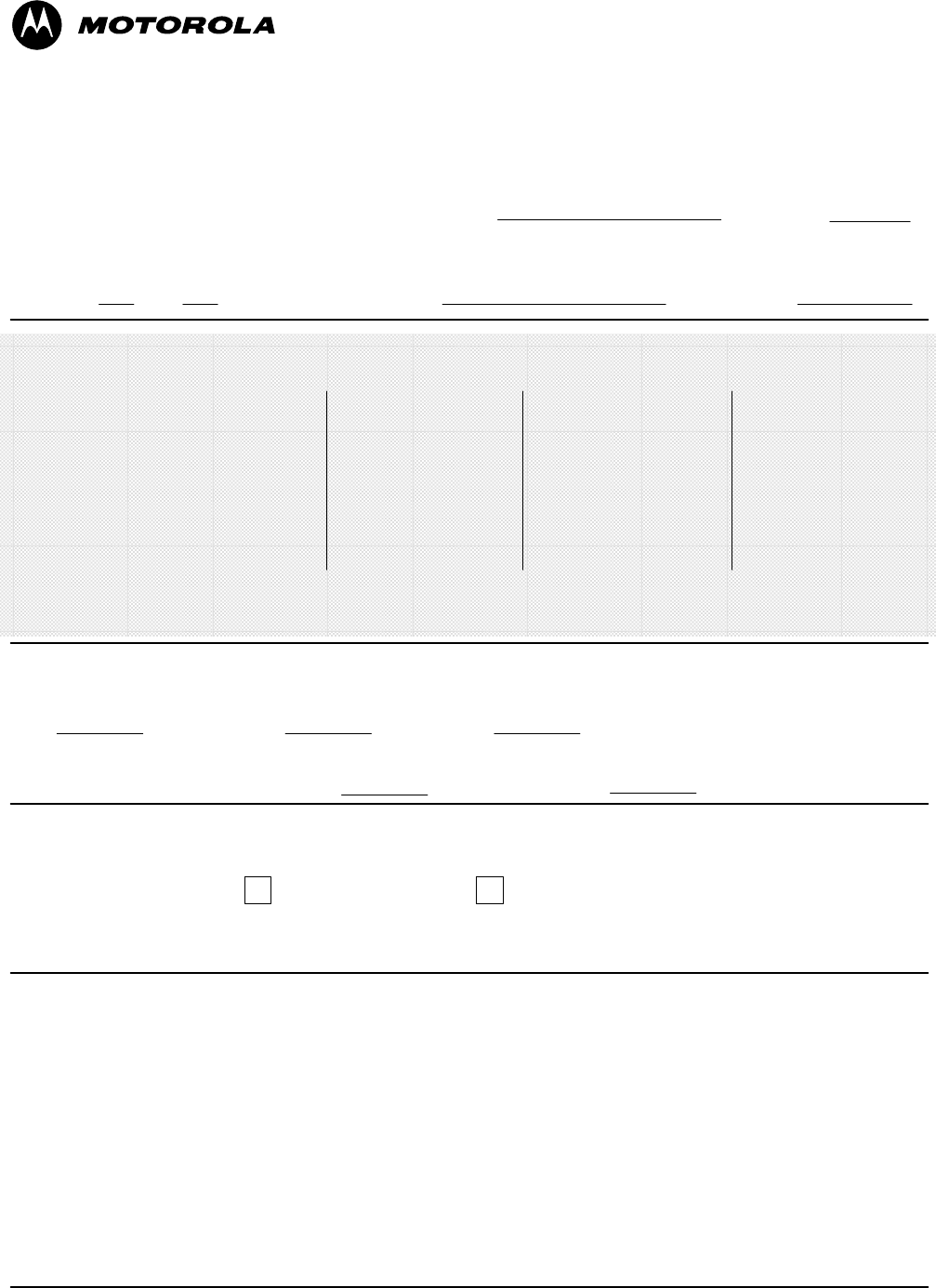
Technical Information Products and Services
11
STANDARD MANUAL PRINTING INSTRUCTIONS
STANDARD SPECIFICATIONS – FOR REFERENCE–DO NOT MODIFY
Part Number: 68P09262A08–1 APC:
Title: 1X SC480 BTS Hardware Installation, Optimization/ATP, and FRU
379
PAPER:
Body: 70 lb.
Inside Cover: 65 lb. Cougar
Tabs: 110 lb. Index
Binder Cover: Standard TED
cover – 10 pt. Carolina
1st. LEVEL TABS:
Single Sided
5 Cuts
Clear Mylar
Pantone 2706–C
Black Ink
2nd. LEVEL TABS: FINISHING:
3–Ring Binder
Slant–D
3–Hole Punched
(5/16–in. dia.)
Shrink Wrap Body
Black ink for body, inside cover, and binder cover.
SPECIAL INSTRUCTIONS
TAB and SHEET SIZE/QUANTITY
7X9 8.5x11 660 11x17
NON–STANDARD SPECIFICATIONS
Tape Bound Corner Stitch
Other: Meet with manager to determine the deliverable.
Sheets = (Total Pages) / 2
Single Sided
7 Cuts
Clear Mylar
White
Black Ink
Filename: 262A08–1
1st Level Tabs 2nd Level Tabs
Volume Jun 2004of DatePrint Vendor: eDOC